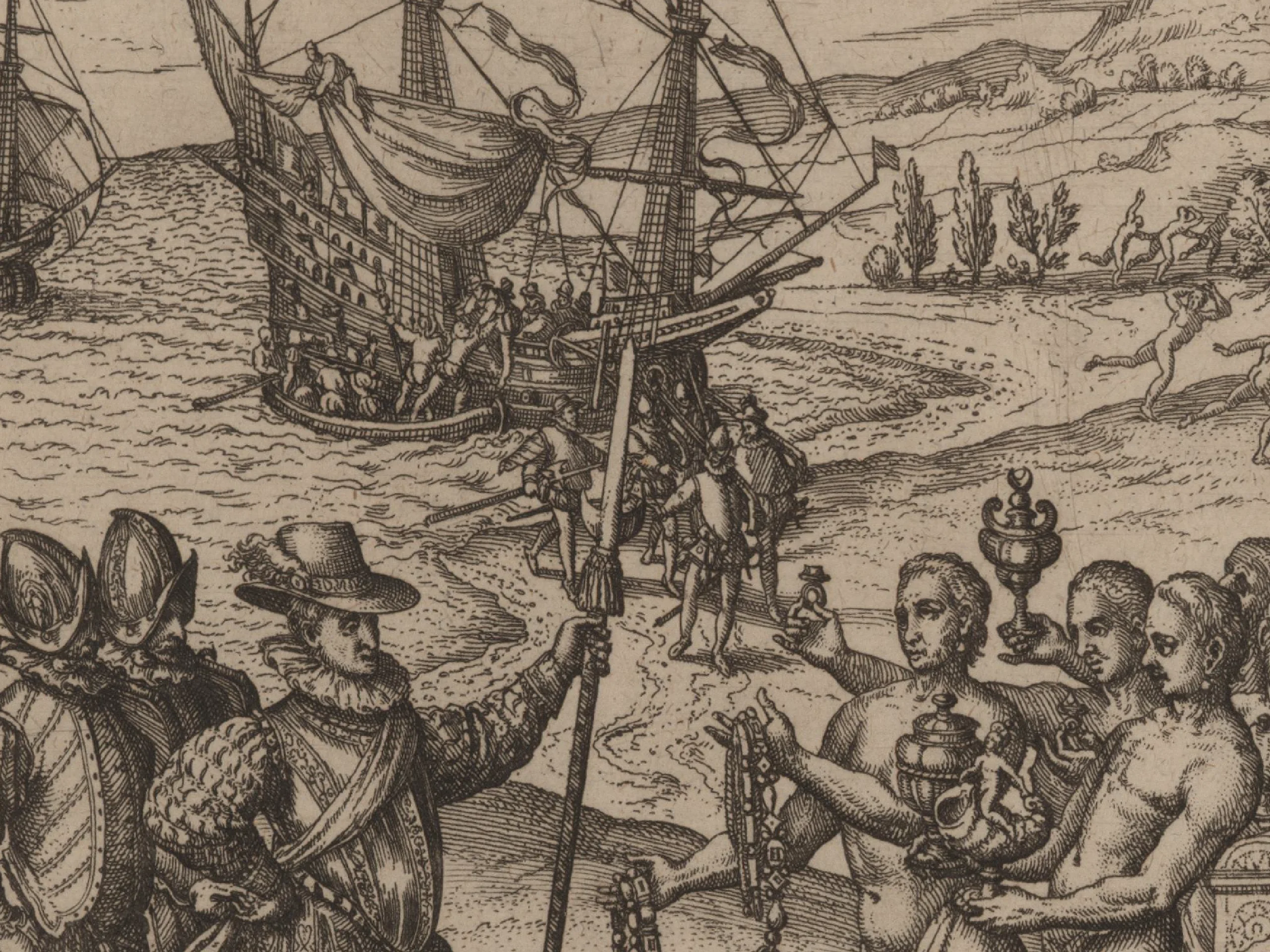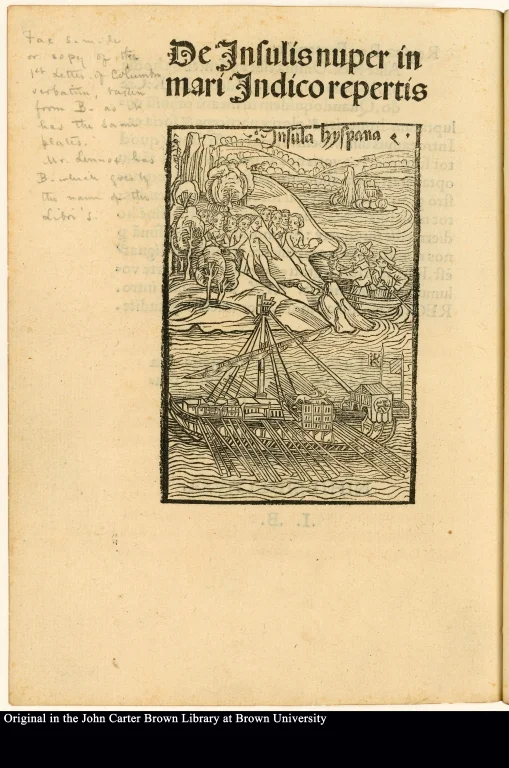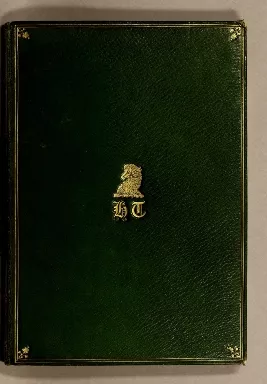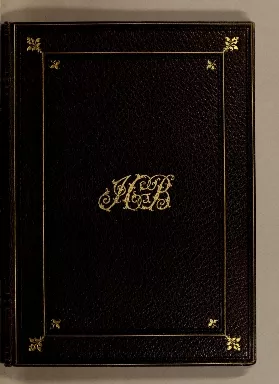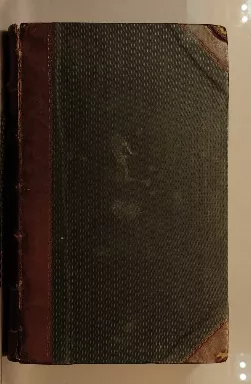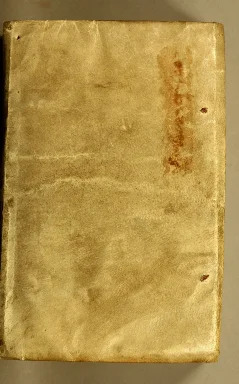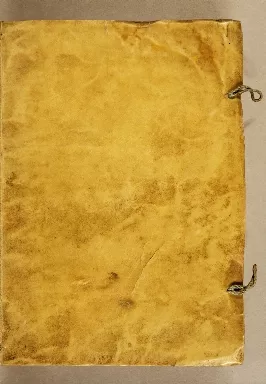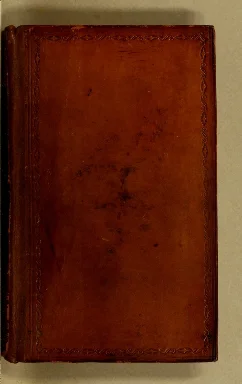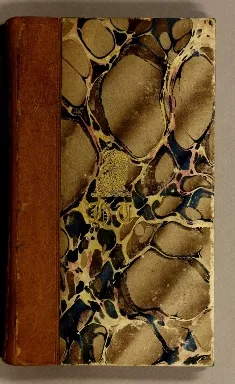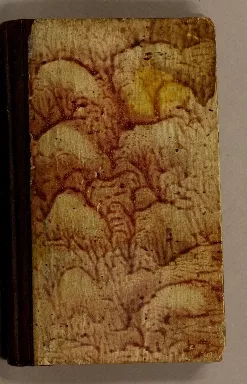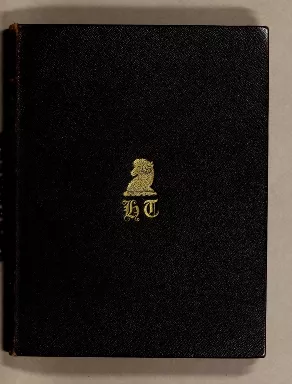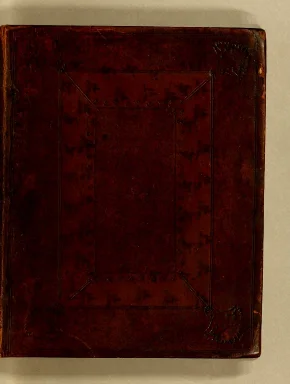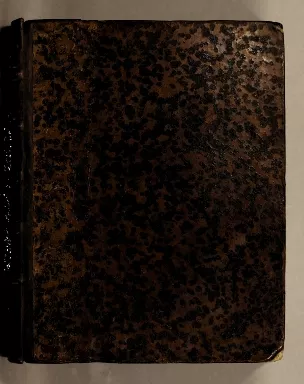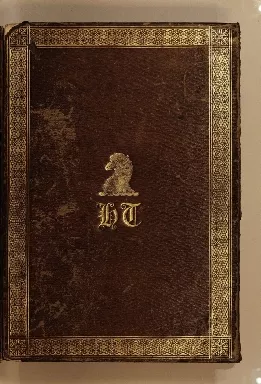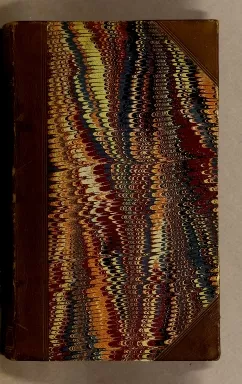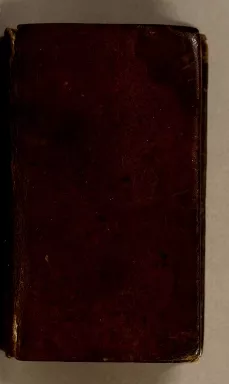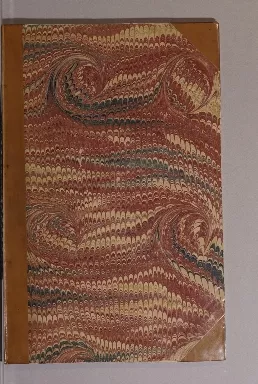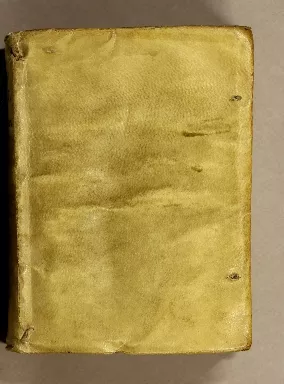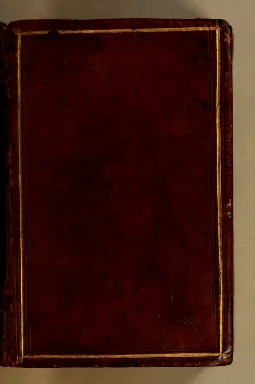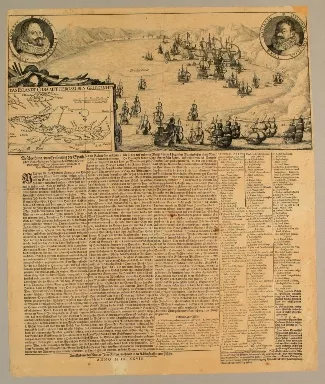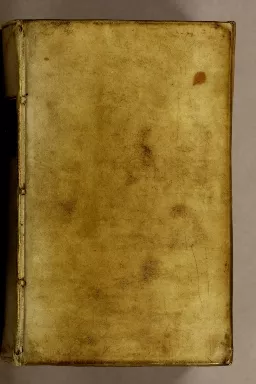1. Geography and History
De Insulis nuper in mari Indico repertis
1492-1600
-
 p. 1
p. 1The earliest Americanum, or book about America, is the famous letter of Christopher Columbus to the court of Spain, reporting on his findings. Its contents anticipate much about how the Spaniards, the first colonizers, viewed the new lands and would continue to view them.
While describing the islands' physical features, Columbus's report focuses on three key points: first, that the islands are rich in gold and other natural resources; second, that these riches are now the property of Spain; and third, that the islands are populated by an attractive and tractable people who by his actions have become subjects of the king and queen. He also believed them to be imminent converts to the Holy Faith.
Columbus saw himself not as an emissary to these people but as the agent of their new ruler. The role of emissary was reserved for his meeting with the great Khan, the leader of a civilization comparable to Spain's, which he expected to find on the Asian mainland. As a technologically inferior culture, the islands were automatically deemed appropriate for conquest.
The explorer stressed that his arrival was an event of high importance and that his claim for Spain represented a victory granted by God to the king and queen. The riches, of which gold is most frequently mentioned, were intended to accrue to the rulers of Spain. In justification of his journey, Columbus promised all the gold their Majesties might require, as well as spices, cotton, mastic gum, drug aloes, and—finally—slaves.
The island natives, who, Columbus observed, were without clothing, were described as timid, guileless, and vulnerable, as well as intelligent, skillful, and pleasing in form. Columbus assumed a mantle of paternalism and generosity, making many gifts and forbidding the sailors to take advantage of the people. Since the islanders had no iron and lacked weapons comparable to the Europeans', he was confident that they represented no danger to the explorers. Aware of their belief that his company was from heaven, Columbus was also unconcerned about the dangers posed by their stories of fierce natives from another island, who were said to be warlike and to practice cannibalism.
Columbus's conception of his mission existed in two dimensions, earthly and spiritual, and was of overarching importance, he believed, in both. The worldly benefits were to come not only to Spain, he concluded, but to all Christians. At the same time, great fame was to be visited on the sovereigns through the religious conversion of untold nations in the new lands—a momentous spiritual event.
Thus began the greatest colonial undertaking of modern times, an empire to rival that of the Romans. Spain would exploit the resources of the New World as its assumed just right in the age-old role of conqueror. It would also export European culture, laying divine claim on a people who appeared to be without the practices of religion. It was a Holy Mission in two realms, and it was to be fulfilled as Columbus envisioned. There is in his letter not the slightest suspicion, however, that the new lands would also have a tremendous impact on the lands of his fathers.
Cosmographiae introductio
1507
-
 p. 7
p. 7Columbus sought a shorter path to the "Indies" and assumed at first that he had reached Asia. "Cuba," for example, he took to be the local name for Japan. While the explorer took note of native names and reported them to his sovereigns, the name "Indies" became inextricably linked with what Columbus recognized by the time of his third voyage to be a rich new territory. He applied the term "Indias Occidentales," or West Indies, in his own writing.
The name "America" happens to resemble a variety of native names, such as Ameca, but we owe its application to the continent to a German geographer. In 1507, Martin Waldseemiiller published two world maps with the new lands identified as "America." Waldseemuller justified such usage in his pamphlet Cosmographiae introductio, which also contained Amerigo Vespucci's accounts of his New World voyages. The pamphlet enjoyed at least four more editions or issues the same year, and the map itself was printed in at least 1,000 copies. The success of Waldseemiiller's booklet propelled the name "America" into popular usage and resulted in the competing usage of "Americans" for the native inhabitants, who continued to be known as "Indians" in other publications.
Waldseemiiller used Vespucci's voyages as his source of geographical information on the New World and mistakenly identified him as the discoverer of the fourth part of the world, after Europe, Asia, and Africa. The name was specifically applied to South and Central America and the West Indian islands. Waldseemiiller drew the curious conclusion that it was proper to name the continent for this eminent male explorer because Europe and Asia took their names from women. The geographer erred even in this perhaps lighthearted suggestion, since the names for Europe and Asia probably derived from the Assyrian words for "West" and "East." The symbolic representation of the continents as women does, of course, enjoy a long tradition.
The success and wide-ranging influence of Waldseemiiller's early maps and writings overtook his own professional reconsideration. By the time he realized his error in assigning priority to Amerigo Vespucci and attempted to recall the use of the name America, it was too late. The name was already too deeply entrenched in common usage.
Vespucci's book of travels appeared in no fewer than thirty editions even before the end of the sixteenth century. It was printed everywhere from Rome to Antwerp and from Paris to Leipzig. While Amerigo Vespucci was not the bold innovator we know in Columbus, he did take part in as many as four transatlantic voyages between 1497 and 1503, and he provided a relatively lengthy and adventurous account of his company's encounters with natives, describing their appearance and customs. One of the earliest portrayals of New World cannibalism appears in his relation. In the story of his third voyage, he described females who killed and ate a young member of the crew while the other Spaniards watched in horror. Telling is Vespucci's account of the process of policy making on the first voyage: the Spaniards first determine to treat the natives as their friends; failing that opportunity, they will treat them as enemies, but in the end, they intend to capture as many as they can and make them their slaves.
Introductio in Ptholomei cosmographia[m]
1512
-
 p. 14
p. 14While the earliest Polish Americanum is Joannes de Sacro Bosco's Introductorium of 1506, Jan ze Stobnicy's introduction to Ptolemy, the second most venerable work, is of greater visual interest because of the two maps apparently issued with it. These maps are clearly copies of the hemispheric representations that appeared at the top of Martin Waldseemiiller's large map of the world in 1507. One of the maps presents the known continents of Europe, Africa, and Asia. The other, the American map (see fig. 1.3), was based in part on the reports of explorations up to that time but also required a sizable leap of Waldseemiiller's imagination in terms of the placement and extent of the land mass. The essence of his achievement is the representation of two continents connected by a peninsula, with information on the Pacific coastline and northern reaches being necessarily limited and conjectural, but with manifest separation from Asia. Waldseemiiller's remarkable graphic proposal was not confirmed until the global circumnavigation completed by Magellan's crew.
For many years, the Jan ze Stobnicy version was the only known copy of the Waldseemiiller map, which was not rediscovered until 1901. It is to the Polish author's credit that Waldseemtiller's work was thus disseminated, though it is unfortunate that he failed to credit the German cosmographer. These maps are probably the earliest of any to be printed on Polish soil, and the captions, less than ideally legible, differ in several ways from the Waldseemiiller original. The name "America" does not appear.
Jan ze Stobnicy (Joannes Stobnicensis), born at Stopnica, Poland, around 1470, was a professor of philosophy at the University of Cracow, one of the great centers of learning in Europe; he later joined the Franciscan order. His geographical text, really a compilation from several authors, is also distinguished by being the first Polish book to contain several firm references to the New World, as opposed to the slight reference to an unspecified new world in Sacro Bosco. Jan ze Stobnicy's American remarks, like his maps, are demonstrably derived at least in part from Waldseemtiller's text, and he credits Vespucci three times as the continent's discoverer, making no mention of Columbus. The fourth part of the world, while named "America" for the explorer, is said to be known popularly as "novus mundus."
Claudii Ptolemaei Alexandrini Geographicae enarrationis libri octo
1535
-
 p. 1
p. 1The power of the ancient Romans was so great, and their travels so wide-ranging, that they necessarily acquired a vast and sophisticated knowledge of geography. Such information was in fact systematically collected. Roman knowledge passed to the Arabs, who preserved and developed it, and it was only with the Renaissance that this ancient knowledge was recovered by Europeans. The discovery of the New World and the growing recognition of its importance in no way diminished the discipline of ancient geography, which remained a subject of active scholarship, as new or modern geography became a field in its own right.
The last great astronomer of ancient times, Ptolemy, was a Greco-Egyptian mathematician and geographer in the second century a.d. He is most famous for working out the earth-centered cosmography that was commonly accepted until the heliocentric Copernican system began to displace it in the sixteenth century. Ptolemy knew perfectly well that the earth was round and prepared estimates, admittedly small, of its size. His treatise on geography is almost as important as his work on astronomy, although it is less well known. The first printed edition of Ptolemy's geography appeared in 1475, and from 1508, editions began to be published with some treatment of the new discoveries in the West. The edition of 1535 is of special interest to Americanists because of the editorial comments of Michel de Villeneuve, i.e., Michael Servetus, a Spanish physician and scholar who worked and traveled across Europe. As an example, on the back of map 28, "Oceani Occidentalis seu Terrae Novae Tabula," Servetus makes an effort to correct existing misapprehensions:
Therefore, those who strive to name this continent "America" are very much mistaken, since Amerigo [Vespucci] went to the same land long after Columbus; nor did he go there with the Spanish, but with the Portuguese, in order to exchange his wares.
Michael Servetus is best known in the history of medicine and science for his landmark discovery of the circulation of the blood through the lungs, announced in book five of his Christianismi restitutio (1553). The impact of this discovery was diminished severely by the early destruction of all but three copies of that publication. To his ultimate misfortune, Servetus also applied himself diligently from his youth to the study of the Scriptures, using the recently printed polyglot texts that widened the availability of the Bible to scholars. Servetus went in search of what he felt to be a simpler basis of theology, distancing himself from the Trinitarian constructs of church doctrine. The Unitarian views resulting were published in De trinitatis erroribus libri septem (1531) and Dialogorum de trinitate libri duo (1532), which aroused the enmity of Catholic and Protestant authorities alike. The books, printed when Servetus was barely twenty years old, were banned and burned, and the author condemned.
The young student assumed the name Michel de Villeneuve (as listed in the Ptolemy), found work as an editor of Classical texts, and pursued a medical career. Despite his success in taking on a new identity and working as a physician for two decades, Servetus eventually felt impelled to seek further publication of his theological views. As a result, he was captured while traveling through the theocracy of Geneva. After having been tried for heresy by Jean Calvin, the founder of the Reformed Church, he was burned at the stake in 1553.
In the trial, Servetus seems to have been one of the first to have identified America as a refuge from the persecutions characteristic of Europe in the Reformation. Calvin's record of the event reports that Servetus charged he would denounce him to the new lands, where he would establish opposition to Calvin's tyranny.
America
1619
-
 p. 1
p. 1With general acceptance of the term "America" for the continent of South America, it was Gerardus Mercator who applied it to the north and introduced in printed form the distinction of North and South America, "Americae pars septentrionalis" and "Americae pars meridionalis." These first appeared in his Latin world map of 1538, which had its basis in Ptolemy. The Mercator names eventually achieved nearly universal acceptance, although some non-standard usage persisted well into the eighteenth century. Some German writers, for example, called most of North America "Kanada," reserving the name "America" for the lands to the south.
Gerardus Mercator began a great atlas in 1585 which was completed by his son Rumoldus ten years later. The Atlas sive Cosmographicae meditationes (first published, Dusseldorf, 1595) is the first complete version of the three-part work. (For a detail of the 1623 edition, see fig. 1.4.) Mercator atlases were extensively published, modified, and augmented in Latin, German, English, French, and Dutch. The Atlas minor, das ist: Eine kurtze jedoch gründliche Beschreibung der gantzen Welt (Amsterdam, 1651) was a more modest atlas, aimed at a wider market, and was an enormous success.
Mercator's greatest impact, however, was the new projection of the world presented in many of his maps after 1568. For navigators' maps of the world, the Mercator projection has been used more widely than any other projection. It has the advantage of showing true direction and presents latitude and longitude as straight lines that intersect at right angles. On the other hand, this cylindrical method increasingly misrepresents areas and distances as one moves away from the equator.
Wunderbarliche, doch warhafftige Erklärung, von der Gelegenheit vnd Sit...
1590
-
 p. 9
p. 9"Virginia," the first English colony in America, was a project promoted by Sir Walter Raleigh, an adventurer seeking to elevate his position in the court. Among those chosen to accompany the colonization attempt in 1585 were his Oxford tutor, Thomas Hariot, and a gifted artist, John White. Hariot, who later established a reputation as a mathematician, had the assignment of studying the customs of the native population and describing the new land's geographical features. White, who served as governor of a later settlement, was to draw and paint what he saw and act as a surveyor.
Raleigh had much to gain from the success of the colony and saw to the publication of Hariot's report as A Briefe and True Report of the New Found Land of Virginia in 1588. On a visit to London, the Frankfurt engraver Theodor de Bry was encouraged, possibly with the aid of Richard Hakluyt, to publish the report together with engraved versions of the watercolors of John White. The magnificent publication that resulted was printed and engraved the same year in four languages: Latin, German, French, and English. It also formed the first volume of de Bry's great series of lavishly illustrated travel accounts, known collectively as his America series or the "Grands Voyages."
Hariot's report, while generally accurate, also served the purposes of propaganda, painting the colony in the most positive light. The illustrations of John White are characterized not only by evident artistic skill but by a high level of accuracy. His portrayal of Indians and nature would establish a standard of presentation, and the images themselves would be copied countless times in the centuries ahead (see fig. 1.1). The work of both men is prized as a careful representation of local conditions at the time of the settlement. Occasionally, the de Bry engravings differ slightly from White's watercolors, bestowing a more Europeanized appearance on the Indians. Contemporary copies of White's originals have largely been preserved and are kept in the British Museum; they have recently been published.
The area actually treated by White and Hariot is Roanoke Island and the coast of what is now North Carolina. The report emphasizes natural resources and products, such as metals, furs, dyes, nuts, turkeys, herring, and local food crops; also provided is an account of the indigenous population and their way of life, accompanied by observations and anecdotes. Even as a man of science, Hariot cannot fully account for the unintended impact of this European incursion. As it is expressed in the English edition, "within a few dayes after our departure from every such towne, the people began to die very fast, and many in short space... This happened in no place that wee coulde learne but where wee had bene." The unavoidable introduction of alien disease to those without immunity (in this case perhaps smallpox), so pernicious to New World populations, could not yet be recognized. Nevertheless, Hariot closes his account with his positive hopes for the new colony, "seing therefore the ayre there is so temperate and holsome, the soyle so fertile." He assumed that an amicable coexistence with the Indians would be possible.
Beschryvinghe vander Samoyeden Landt in Tartarien
1612
-
 p. 9
p. 9The first work in this small compendium edited by the Dutch cartographer-bookseller Gerritsz is Isaac Massa's description of Russia, which gives the volume its title. Massa, born at Haarlem in 1587, and hence a countryman of Gerritsz's, was sent to Moscow in his teens to learn about commerce, especially the silk trade. He remained in Russia for eight years, during which time he also learned much of Russian geography and history and compiled reports from explorers.
Massa's account of Russia and Tartary focuses on the people and natural phenomena, but he closes it with the opinion that the inhabitants of America arrived there by crossing the "Anian Strait" between Asia and America. This idea had already been proposed by Jose de Acosta in 1588, but it is all the more significant when voiced by a visitor to Russia who had contact with explorers at a time when little was known about Siberia. Massa reported estimates of the Anian Strait's breadth to be as great as 100 miles, though he thought it more narrow. What we recognize today as the Bering Strait has a width of only 56 miles.
The two hemispheres shown in Gerritsz's world map (fig. 1.5) feature the various discoveries mentioned in the volume and display both the further reaches of Asia and the assumed extent of North America. On the overleaf to the map of Siberia, Gerritsz elaborates on the question of migration, mentioning Massa's proposal and New France. In his preface, he discusses Henry Hudson's search for a Northwest Passage, as well as Martin Frobisher, Newfoundland, Virginia, Peru, and the writings of Acosta. The last item in the volume is Pedro Fernandes de Queiros's Verhael van... Australia incognita, translated from his 1610 Pamplona memorial requesting permission to establish a new colony in the Pacific.
Later the same year, Gerritsz issued a new edition with a supplement containing the first printed accounts of Hudson's North American discoveries, as well as the earliest separate map of Hudson Bay and the adjacent country, detailing the area shown on the world map in this first edition. The full work soon appeared in Latin and was reprinted in 1613, finding its way also into the de Bry family's East Indian series in German and Latin.
The royal commentaries of Peru, in two parts
1688
-
 p. 9
p. 9Anchored in two worlds throughout his life, Garcilaso de la Vega was born at Cuzco, Peru, in 1539, the son of a Spanish conqueror and an Inca princess. His cultural dichotomy and the relationships from which it stemmed informed his life's work. As a child, he was steeped in the oral tradition of the Inca, whose history he was encouraged to chronicle. Yet at the age of twenty, he was called to Spain and lived out his adult life there, never to return to South America.
His first work, La Florida del Inca, written about 1584, was first published in Lisbon in 1605. This study of Hernando de Soto, while a work of non-fiction, had something of the narrative quality of a novel, with its battle scenes and dialogues. The author viewed de Soto's mistaken journeys as a tragedy reflecting both man's greatness and the ultimate futility of many of his endeavors. Significantly, the book was not published in Spain until the eighteenth century, but was already translated into French by the mid-seventeenth century.
Garcilaso's second important work, the culmination of his life's efforts, was the Commentarios reales, que tratan del origen de los Yncas, reyes que fueron del Peru, first published, Lisbon, 1609 (part 1) and completed, Cordoba, 1616, just before the author's death. While indisputably a historical narrative, the literary properties of this book qualify it as the first great work of Spanish American literature.
The first part, a treasury of native American heritage, relates the story of the Inca before the arrival of Europeans. It gives an account, as retained from stories learned by Garcilaso as a child and youth, of Inca history, government, religion, and custom. The second part relates the Spanish conquest of the Inca, including criticism that would be unavoidable in any history other than a whitewash.
While recognized today as a responsible work of history, it incurred the wrath of contemporary Spaniards, who pointed to the author as an Indian and defamer of Spain. Yet Garcilaso had no such intention, truthfully recounting historical fact and even judging the Spanish conquest as a worthy and important development for his people, in its bestowal of Christianity. In this regard, he differed from Bartolome de las Casas, who discredited the whole colonial undertaking. Nevertheless, the Spanish court eventually forbade the sale of Garcilaso's book as a rebellious and anti-Spanish document.
An abridgment appeared in English as early as 1625, and the first part was translated into French by 1633. In 1688, the full work appeared in English. While an imperfect translation of Garcilaso's original, this English edition is of greater visual interest than the first Spanish edition, which is not illustrated. Chapter eleven of the second part, relating the arrival of Pizarro in Peru, tells of the fear of the Indians upon seeing a tall European in armor, Pedro de Candía. The complex entanglement of the author with the narrative is conveyed by Garcilaso's note that he went to school with the son of this Pedro de Candía. One is touched by his caution in citing a Spanish source for another anecdote, a story from Pedro de Cieza de León, "that so I might have the Testimony of a Spanish Author, in confirmation of the truth of what I have wrote."
The sea-atlas or the watter-world
1660
-
 p. 1
p. 1One of the essential tools of the navigator was the nautical chart that accurately portrayed the seacoasts. In the seventeenth century, it was the Dutch who, as masters of the seas, pioneered in the production of quality land and sea maps and atlases. Working chiefly in Amsterdam, they printed in Dutch, French, Latin, English, German, and Spanish, fairly dominating the European trade for a century.
Hendrick Doncker was one of the most prolific publishers of maritime works in the latter part of the seventeenth century. His success is evident in the wide distribution of his sea atlases and navigation books, which were distinguished by being the most up-to-date of any available in his time. Doncker's Zee-atlas, first published in 1659, was an important, original creation that went through editions with prefatory text and title pages in English (The Sea-Atlas, 1660), French (L'Atlas de Mer, 1689), and Spanish (La Atlas del Mundo, [1669]), as well many Dutch editions. His later Nieuwe Groote Vermeerderde Zee Atlas, 1669, was a still larger work in format and volume, and its publication was continued and further improved by Doncker's son, also named Hendrick.
The elder Doncker's Sea-Atlas, as here represented, merely masquerades as an English edition; it is a collection of navigational charts with place names in Dutch and is fitted out with the standard Dutch preface-only the title page is in English. Yet at least one 1660 copy survives with text in English, proving the existence of that edition.
The preface describes such colonies as Brazil, Cuba, Florida, and Peru, and provides a short history of world navigation, including the American discoveries. The ten American maps in this copy show coastlines stretching from Greenland and New France in the north to the Strait of Magellan, as well as the islands of the Caribbean.
"Profedens," appearing on the map of New Netherland, Virginia, and New England, is thought to be the first appearance of Providence, Rhode Island, on a printed map. The listing of such neighboring places as "Warrick," "Klips kil" (Fall River), "Pleymuyt," and "Baston" indicates the settlements of importance. New Netherland as here laid out is shown in the twilight of its existence; in 1664 it would yield to British control. The Dutch settlements eventually became part of the states of New York, Connecticut, New Jersey, Delaware, and Pennsylvania.
Nouvelle decouverte d'un tres grand pays situé dans l'Amérique, entre ...
1697
-
 p. 1
p. 1Hennepin's Description de la Louisiana (Paris, 1683) was the first printed account of Louisiana, as well as the earliest description of Niagara Falls. The work is amplified in his Nouvelle decouverte, which also provides the first engraved view of the falls. In the London edition of 1698, A new discovery of a vast country in America, he writes,
"Betwixt the Lake Ontario and Erie, there is a vast and prodigious cadence of Water which falls down after a surprizing and astonishing manner, insomuch that the Universe does not afford its Parallel.
. . . The Waters which fall from this horrible Precipice, do foam and boyl after the most hideous manner imaginable, making an outrageous Noise, more terrible than that of Thunder. . . . From the great Fall. . . the two Brinks of it are so prodigious high, that it would make one tremble to look steadily upon the Water, rolling along with a rapidity not to be imagin’d."
The author discounts comparisons with Switzerland and Sweden as inadequate to describe the Niagara.
Hennepin was a Franciscan Recollect friar who took part in the expedition that discovered the upper Mississippi. He was captured by the Sioux but rescued a few months later, and returned to France, where he began to publish. The magnificent achievement of his narratives is shrouded in controversy as a result of his extravagant claims that he was the expedition's leader and that he traveled on to the mouth of the Mississippi. Despite an earnest desire to return to North America, he failed to gain royal approval. The narratives remain a rich source for descriptions of Indian life and of nature, even if Hennepin's assertions cannot always be accepted.
2. Missions and Religious History
Copia dela bula dela concession q[ue] hizo el papa Alexandre sexto al Re...
1511
-
 p. 1
p. 1In the era of the discoveries, the Catholic Church in Rome was not only the seat of responsibility for foreign missions, but was still the only supranational authority available for the arbitration of conflicting interests. By the closing years of the fifteenth century, the papacy was approaching the peak of its outward splendor, even if its claim to universal political sovereignty had been broken with the death of Pope Boniface VIII, nearly two centuries before. Alexander VI, pope from 1492 to 1503, was a Spaniard whose illegitimate children included Cesare and Lucrezia Borgia. The personal power and corruption associated with his reign made his name symbolic of worldly impiety.
In 1493, Alexander VI established the legality of Spain's New World claims by setting a line of demarcation in the Atlantic Ocean, assigning lands and waters east of the line to Portugal, and those west to Spain. Being just one hundred leagues west of the Cape Verde Islands, it effectively granted all of America to Spain, while according India and Africa to Portugal. The following year, the countries themselves confirmed the pope's ruling through the Treaty of Tordesillas, but moved the line 270 leagues further west, in the interest of Portugal's African and maritime pursuits. The new line, running through the eastern projection of South America, established the legal basis for the future Portuguese colony of Brazil. At the time of the treaty, geographical knowledge was still very limited, and it continues to be debated whether Portugal was secretly aware that the movement of the line to the west would give it control over a large portion of South America.
The 1493 Bull was of sufficient importance for Spain to be printed twice around 1511, but neither Spain nor Portugal chose to make the land grants to the papacy that a bishop had proposed in 1493 as a reward for the pope's role in arbitration. Lacking the resources for the large campaigns needed for the conversion of the natives, the Church turned the financing and administration of missionary activities over to the Spanish crown.
Histoire de la mission des peres Capucins en l'isle de Maragnan et terre...
1614
-
 p. 5
p. 5Claude d'Abbeville's history of the French Capuchin mission to Maranhao seems to be the earliest account of that island off the coast of Brazil. It is also an expression of the competitive spirit between the Capuchins and their rival missionaries, the Jesuits, with whom they also contended in Canada. The Capuchin author only remained for about four months in the colony, returning to Paris with six Indians whose presence in the city caused a sensation. He sought to promote the colony, emphasizing the positive, as exemplified in the portrayal of the ideal of peaceful conversion of the naked masses. The accompanying illustration (fig. 11.1) shows Spaniards and Indians, soldiers and priests kneeling together, all equal before the symbol of the Church.
The French colony was a political liability, however, being conducted on land already claimed by Portugal. The mission was cut short after the marriage of Louis XIII in 1615 to a Spanish princess, in an effort to maintain good relations with Spain, which was then in political union with Portugal. Claude d'Abbeville's descriptions of nature and the Indians of Maranhão remain as the intellectual legacy of that short-lived mission.
Question moral si el chocolate quebranta el ayuno eclesiastico
1636
-
 p. 7
p. 7The author of numerous legal and historical papers, Leon Pinelo was born in Peru and served Spain's Consejo de las Indias as an advocate. In Question moral, he pondered the ethical problem of priestly consumption of chocolate as a drink before mass. He concluded that it does not break the fast, but discoursed at length on chocolate, its origin, and methods of preparation. His work stimulated a controversy that continued into the eighteenth century. Along the way, he also considered the issue of priestly smoking. Citing various ecclesiastical regulations, Leon Pinelo concluded that priests would sin grievously by smoking tobacco prior to the celebration of mass.
In this same volume, the author described nearly every beverage known at the time (i 18 in all), particularly those of America. The drinks include cassava beverage, a drink made from the coca plant, and pulque, which is made from the aloe plant. The author took a negative view of the excessive consumption of some beverages by Indians.
A key into the language of America: or, An help to the language of the n...
1643
-
 p. 3
p. 3The exacting spiritual standards Roger Williams employed and his particular interpretation of Christianity's mission led to repeated conflicts with his fellow churchmen in New England. He took issue with the various ways civil authorities in Massachusetts impinged on freedom of conscience, with the eventual result of his banishment in 1635. Traveling southward in 1636, Williams turned his energies toward the creation of a new colony where differing religious views could flourish in a spirit of toleration. His leadership in Providence and nearby settlements also led to the development of government forms that were, in general, more responsive to the consent of the governed than those in Massachusetts had been.
Roger Williams was among the first ministers in New England to take a serious interest in the conversion of the Indians. The months he spent living among them and learning about their life gave birth to his book, A Key into the Language of America. At the time, Williams was nearly unique among English colonists in his interest in native culture and religion, treating his Indian neighbors as equals. He was also the first New Englander to consider their legal rights, arguing against the legitimacy of royal land grants in Massachusetts and purchasing land directly from Indians when he founded the colony of Rhode Island. He continued to work for fair and egalitarian treatment of the Indians, with the result that he was able to forge successful alliances that benefited all of New England until the time of King Philip's War.
Williams's linguistic treatise touched on every aspect of Indian life, providing Narragansett vocabulary and anecdotes to assist the reader's understanding. The topics of chapters included salutations, eating and entertainment, sleep and lodging, names for numbers and family relationships, household business, parts of the body, basic communications, telling time, and the seasons. Further chapters dealt with travel, the heavens, weather, animal and plant life, fish and the sea, nakedness and clothing, religion, government, money, trading, hunting, games, war, art, illness, and death.
Everywhere there is evidence of his egalitarian spirit. In naming the parts of the body, Williams observed, "Nature knows no difference between Europe and Americans in blood, birth, bodies &c. God having of one blood made all mankind, Acts 17." In his chapter on religion (see fig. 11.4), he was careful to include Indian religious terms and concepts along with those he used to explain Christian doctrines. He reported a discussion with a Connecticut Indian in which the source of religious authority was at issue. The Indians accepted their ancestors' oral tradition that souls go to the southwest, but no one could tell of the destiny of souls by experience. An Indian noted, however, that the Englishman brought "books and writings, and one which God himself made, concerning men's souls, and therefore may well know more than we that have none, but take all upon trust from our forefathers."
Already in New England, Williams had doubts about the legitimacy of conversion; as his religious thinking continued to develop, he began to question whether Indian religious practices should be displaced by those of the Europeans, a sentiment that ended his work in missions.
Rosa de S. Maria virgo Limensis è Tertio Ordine SS. P. Dominici
1668
-
 p. 7
p. 7The very first American to be declared a saint by the Roman Catholic Church was Rosa of Lima in 1671, nearly two hundred years after Columbus first carried Christian beliefs to the New World. Born in 1586 to parents of Spanish extraction, she appears to have been an unusually devout child. Having taken a vow of virginity fairly early in life, as well as showing many other signs of disowning a worldly existence, she became a Dominican nun at the age of twenty. Especially in adult life, she turned to self-denial and mortification, habitually wearing a spiked metal crown and a girdle of iron chains, and lying upon a bed of thorns, glass, stones, and potsherds. The hallucinations associated with severe fasting understandably took, for her, the form of religious imagery.
Following her death in early adulthood in 1617, various miracles are said to have taken place. She was beatified in 1667, just fifty years later. The standard biography of the Peruvian saint, Leonhard Hansen's Vita mirabilis . . . sororis Rosae de S. Maria, was first published in Rome in 1664, quickly becoming a bestseller across Europe. It was printed in Spanish in 1665, in Polish in 1666, in German in 1667, in Flemish in 1668, and in Portuguese in 1669. Multiple editions appeared in each language as Rosa's fame spread among the faithful.
Even before the success of Hansen's volume could be predicted, those who wished to promote Rosa's cause sought the widest possible circulation for her life story. Antonio Gonzalez de Acuna, advocate for her beatification in the Vatican, arranged for the preparation of a concise biography, based upon Hansen, that could be sold more cheaply than the latter book. A young theological student in the Roman College, Giovanni Lorenzo Lucchesini, agreed to take on the task.
The resulting volume, the product of Lucchesini's literary skill, had success comparable to the work on which it was based. The Compendium admirabilis vitae Rosae de S. Maria Limanae (Rome, 1665) was reprinted in Latin under various titles, carrying with it the name of Gonzalez de Acuna, who had seen to its approval and publication. The edition exhibited also included documents regarding her beatification. French and German translations were printed in 1668, and a Spanish edition appeared at Rome in 1671. Several French editions were even followed by an abridged French version. The work was routinely associated with the Dominican Gonzalez de Acuna's name until 1696 when the name of Lucchesini at last appeared on the title page of the ninth Latin edition, printed at Rome. Despite accusations of plagiarism, the literary responsibility of Lucchesini, a Jesuit, was ultimately vindicated. Understandably, various editions continue to be cataloged under Gonzalez de Acuna's name even today.
Antinomians and Familists condemned by the synod of elders in New-England
1644
-
 p. 1
p. 1Writers on religion in the seventeenth and eighteenth centuries, while generally impatient with heresies of whatever kind, seemed to have a special reserve of ire to vent on those religious traditions, like that of the Quakers, that permitted women to contribute to religious thought. Such an element was certainly involved in the persecution of Anne Hutchinson, who became part of the Antinomian controversy. The name "Antinomian" was applied to those who were perceived as placing themselves above the moral law of the Old Testament. John Winthrop, governor of the Massachusetts colony, describes her in this way: "Mistris Hutchison ... a woman of a haughty and fierce carriage, of a nimble wit and active spirit, and a very voluble tongue, more bold than a man, though in understanding and judgement, inferior to many women." Winthrop grants her wholesome scriptural teaching, but contends that she "dissembled" in order to join the church of Boston and charges that in private religious meetings, she quickly began "to set forth her own stuffe." Moreover, as a midwife, she was in a position to have considerable influence in the community.
Winthrop lays out the exchanges with Hutchinson in court, where she was charged. Her reasoned replies to her interrogators are rich with scriptural references and sensible observations. The authorities' reply, however, is: "you shew not in all this, by what authority you take upon you to be such a publick instructer." Her chief doctrinal crime seems to have been her belief in a "covenant of grace" in which the individual may experience direct intuition of divine grace and love, as opposed to the accepted doctrine of the "covenant of works." Hutchinson's offense, however, may be attributed in equal measure to her having overstepped the bounds of her feminine station. She defended herself by arguing that she was trying to follow the Apostles, a role traditionally associated with males. The assembled gentlemen appeared genuinely to fear that the gospel would be driven out of New England, and the result was a sentence of banishment. Hutchinson was identified with the worst Anabaptist excesses of Europe, with Satan threatening the Kingdom of Christ.
Anne Hutchinson and her family first moved with some supporters to a new colony on Aquidneck Island, present-day Newport, Rhode Island. Following the death of her husband, the family moved to New Netherland, a colony known for its relative tolerance. There, all but one member of her household were murdered by Indians in 1643.
Anabaptisticum et enthusiasticum Pantheon und geistliches Rüst-Hauss wi...
1702
-
 p. 1
p. 1To state-church conservatives, the left-wing radical reformers were anathema. In particular, the Anabaptists or Mennonites, largely peasants with simple Christian enthusiasm, were marked by association of name with the most radical of their number, the revolutionaries who established a commune at Munster in Westphalia. Far from the modest, conservatively-styled agricultural Mennonites of the nineteenth and twentieth centuries, the Anabaptists at Munster sought in 1535 to "reform" the very foundations of society, forbidding private property and traditional marriage. When Catholic forces with much slaughter retook the city, in their extreme reaction, they forbade any form of Protestantism.
More than a century later, the Society of Friends—the Quakers—were also to become the subject of much fear and loathing. While emphasizing inward spiritual experience in reaction to the formalism of Christianity in seventeenth-century England, the Quakers had some adherents who, in their enthusiasm, turned to shrieking and trembling with religious ecstasy. Others exhibited various forms of unusual behavior, appearing nude at public meetings, prophesying, or wearing sackcloth. The Anabaptisticum et Enthusiasticum Pantheon, a complex collection of German tracts featured here, highlights strange stories of Quakers committing murder and defiling religious articles. The work sought to expose all such excessive behavior, presenting stories and portraits of those who were felt to be the chief theological malefactors, like James Naylor, a Quaker with messianic tendencies; Jacob Arminius, who sought to soften the harsh determinism of Calvinism; and Menno Simons, a leader of the Dutch Anabaptists. Other illustrations emphasize violence and bizarre behavior. In fact, every departure from Orthodoxy, from the arch-heresy of Socinianism to New England Congregationalism, is held up to ridicule. In one illustration (pp. 168-169), representatives of suspect groups are shown, and the sectional head announces chapters on Quakers, Ranters, Robinsonians, Jews in England, and the conversion of the Indians.
In actuality, the editors fall short of presenting the horrors on every page that seem to be promised by the sensationalistic title pages; this is especially true of American subjects. A section on the conversion of the inhabitants, "Wie sie mit den Indianer verfahren," is a fairly straightforward, selective synopsis of early Puritan missions, citing essential English publications; a footnote on the savagery of Indians is the only part to suggest misdeeds of any kind. A separate publication on Oliver Cromwell and Hugh Peters, Der verschmitzte Welt-Mann und scheinheilige Tyranne, also issued in the collection, enumerates the beliefs of "Independents" or Congregationalists and lists, in a suitably negative tone, the ways the New England branch purportedly differs from the English. "The Law is no rule or guideline for life," and "It is indecent if one wishes to force a Christian to do good works," are among the tenets attributed to their religious code.
Magnalia Christi Americana: or, the ecclesiastical history of New-England
1702
-
 p. 1
p. 1Even as successful experiments in religious toleration were being conducted in Rhode Island and Pennsylvania, another voice in Massachusetts pointed back with nostalgia to a simpler past when only right thinking was rewarded, and those who strayed from the prescribed path found banishment and death. Cotton Mather, the brilliant son of a family prominent in Boston church history, prepared a theological retrospective that outlined the Puritan struggle in the first eight decades on American soil. Opening with a line paraphrasing Virgil, Magnalia Christi Americana was intended to be a great epic history of New England. Through a collection of biographies, chiefly of ministers and governors, it painted such a rich portrait of early colonial life that it served as a source for numerous American authors, including Hawthorne and Melville.
Emphasizing the lives of exemplary men such as John Eliot, John Winthrop, and William Bradford, Mather's biographies presented moral lessons and engaging anecdotes; he delivered poignant accounts like the Indian captivity of the bravely resolute Hannah Swarton and admirable stories of model "praying Indians." The narrative also contains sermonizing and attacks against what Mather regarded as a decline in religious values. The idea that one might achieve salvation in any sect, as long as one conducted life diligently and conscientiously under its teachings, seemed to him a principle "fitter for Mahometans than Christians".
The latter part of Mather's history concerns those he felt to be the enemies of the New England Congregational establishment, figures like Roger Williams, Anne Hutchinson, and the defendants in the Salem witchcraft trials. Though he was a man of science known to intellectuals in Europe, and an early proponent of inoculation against smallpox, Mather accepted the existence of witchcraft as a reality and related in detail the accusations against the supposed witches. The thoughtful author of 450 printed and manuscript works nonetheless cast a critical eye on some of the proceedings, conceding that mistakes had been made in the Salem trials.
An account of the Society for Propagating the Gospel in Foreign Parts, e...
1706
-
 p. 1
p. 1The English were the first Protestants to mount organized missionary campaigns. Under Cromwell, an ordinance was passed in 1649 establishing the Society for the Propagation of the Gospel in New England. The charter of this organization was strengthened when the monarchy returned to the throne. Soon the Society of Friends, or Quakers, began their own efforts. In 1701, Dr. Thomas Bray, having visited Maryland under the official auspices of the Church of England, secured a patent for the Society for the Propagation of the Gospel in Foreign Parts. The Anglican Church thus launched a campaign not merely directed at the souls of the Indians, but in competition with the Catholic Church, especially with their renowned front line troops, the Jesuits.
The Society's plans and reports were routinely publicized in printed sermons and other papers. One of the earliest such sermons contains the discussion of a report from Robert Livingston, Secretary for Indian Affairs in New York. Livingston maintained that the Indians of New York were in urgent need of ministers to instruct them in Christianity. The "French Jesuits," he noted,
were by all Arts and Terrors endeavouring to make Proselytes of them and had drawn over a considerable Number of them to Canada . . . where they had Priests to instruct them, Land to plant, and Soldiers to protect them in Time of War.
Livingston urged the "redeeming of the poor Indians from this Slavery to the Popish Priests" and the establishment of programs to instruct them in the "plain and true Principles of Christianity" (as opposed to the Roman doctrines). He then set forth how this was to be done. Missionaries, he said, should go and live among the Indians, learning their language, and erect a chapel and house. "And that each Minister should be furnisht with some cheap Toys, to give to the Indians, and so engage their Affections, as was the Custom of the French Jesuits among them &c."
The concerns expressed in the report are not only focused on spiritual welfare but touch on other abuses threatening the Indians' survival. As related by another correspondent in the same report (Mr. Moor),
The Indians are daily wasting away, and in forty years it seems probable that there will be scarce an Indian to be seen in all the English Parts of America. In the mean Time the Christians selling the Indians so much Rum is a sufficient Bar, if there were no other, against their embracing Christianity.
The reports discuss numerous problems faced by the missionaries, such as the difficulty in convincing Indians that Englishmen wish them a place in heaven when they steadily deprive them of space on earth.
Neuer Welt-Bot
1733
-
 p. 8
p. 8The particularly strong missionary commitment of the Jesuit order and the political dimension that was commonly one of its facets are both displayed in this book as these traits came to be employed among the Chiquito Indians of Paraguay. Originally composed in Italian, the work was first published in Spanish as the Relacion historial de las misiones de los Indios, que llaman Chiquitos (Madrid, 1726). The first German edition appeared in 1729 under the title Erbauliche Geschichten derer Chiquitos. Italian and Latin editions were printed a few years later.
While chiefly an account of new missions to the Chiquito Indians, including descriptions of the population and environment, the work also contains stories of journeys and missions to various other Indian groups, the discovery of the Rio Paraguay, and the incursions of interlopers from Sao Paulo on the Paraguayan missions. The German editions added a description of Guiana and Cristobal de Acuna's account of the Amazon River, originally published in French in 1682.
The Jesuits in Paraguay oversaw the most famous of the "reductions," communal settlements of Indians begun in the seventeenth-century colonies to facilitate the teaching of Catholicism and Spanish ways and to make the most effective use of native labor. The missions prospered, and the Jesuit caretakers tried to protect the Indians against outsiders who robbed or kidnapped them for slavery.
Martin Dobrizhoffer, an Austrian Jesuit missionary who later came to Paraguay and prepared his own ethnographic study, wrote that some of the Indian accounts related by Vandiera strained his credulity. The work nevertheless provides a fascinating record of missionary efforts and perceptions.
Pennsylvanische Nachrichten von dem Reiche Christi, Anno 1742
1742
-
 p. 3
p. 3Born at Dresden in 1700, Zinzendorf was raised in the atmosphere of German Pietism. The movement emphasized study of the scriptures and personal religious experience, in opposition to the formalism of orthodox Lutheran practice. Much of Zinzendorf's belief was formed by his godfather, Philipp Jakob Spener, the early leader of the Pietist movement; in time, Zinzendorf developed the view that Christianity could more effectively be spread by loose collections of believers outside the Lutheran church.
In 1722, Zinzendorf began accepting German refugees at his estate in Saxony. Members of the Moravian Brethren, an independent Christian sect predating the Reformation, were fleeing Catholic persecution in Bohemia and Moravia. The village of Herrnhut, established on his estate, soon attracted not only many Moravians but adherents of various other persecuted sects. Zinzendorf established a common order of worship for the assembled Moravians, Pietists, Separatists, Schwenkfelders, and others, and organized them on the model of family life. A vigorous publishing program issued vast numbers of books, tracts, hymnals, catechisms, and small Bibles.
Under his leadership, the Moravians were the first Protestant body to declare officially that the evangelization of the "heathen" was a duty of the church. From 1732, a broad program of missions began, sending representatives to slave populations and Indians in the West Indies, Greenland, and North America. Before Zinzendorf's death, missionaries also traveled to the Baltic countries, Surinam, North Carolina, parts of South America, the East Indies, and South Africa. Zinzendorf himself traveled to the Caribbean and North America on behalf of the Moravians, as related in part by his Pennsylvanische Nachrichten, a work first published as a series of pamphlets in Philadelphia. In this work, the count tells of a remarkable conference at Germantown in January 1741/2, when he approached all the evangelical Pennsylvania sects with his unifying zeal. In the first of several conferences, Quakers, Mennonites, Dunkers, Schwenkfelders, Separatists, Hermits, members of the Ephrata community, and others delivered opinions and were brought to joint agreement on several resolutions. If Zinzendorf had intended with these meetings to forge a single religious body under Moravian leadership, he was disappointed, but the firm missionary commitment of the Moravian Brethren survived him.
3. Ethnology
Merueilleux et estrange rapport, toutesfois fidele, des commoditez qui s...
1590
-
 p. 1
p. 1The town of Secota, as painted by John White, was one of the illustrations used in de Bry's version of Hariot's "Virginia" pamphlet, here shown in its French translation, Merveilleux et Estrange Rapport. The engraving shows the Indian habitations, gardens with tobacco (E) and pumpkins (I), a ceremonial fireplace (K), a guardhouse to spot animals in the cornfield (F), planting distance between cornstalks (H), the place of the ceremonial dance (C), the place of communal dining (D), a place of prayer (B), and the tombs of their rulers (A). White's original watercolor lacks the identifying letters, but labels the three cornfields as showing different stages of growth.
The English edition of Hariot's work is fairly familiar, but the French edition is less often exhibited. Like item number 6 in this catalogue, Hariot's German edition, this volume represents the first book in Theodor de Bry's monumental illustrated series on the Americas. Only with this first work did de Bry attempt to publish French and English editions in addition to those in Latin and German; but it did prove feasible to produce another twelve volumes in uniform Latin and German editions. The de Bry family also issued a similar, splendidly illustrated series to publicize the voyages made to the East Indies, "India Orientalis." The John Carter Brown Library holds complete sets of both series, as well as various subsequent editions
The manners, lawes, and customes of all nations
1611
-
 p. 9
p. 9Johann Boemus was a Catholic priest in Ulm, Germany, where he earnestly studied Hebrew language and literature, learning much from the town’s Jewish population prior to their forced departure in 1498. Boemus’s intense interest in other cultures led to a comparative study of customs and mores. This frequently published work, first printed in 1520, was amended as early as 1542 to include American material. From that year, extracts from various sources, including Damião de Góis, Girolamo Giglio, Maximilianus Transylvanus, and Jacob Ziegler, were added to the editions and translations. In 1604, a portion of Jean de Léry’s famous work on Brazil was added to a Latin Boemus edition and both texts were translated into English in 1611. Of the many editions of Boemus, in various languages, only a few contain the Léry extract.
Léry’s original Histoire d’un voyage fait en la terre du Brésil (La Rochelle, 1578) concerned Villegagnon’s attempt to form a French colony in Brazil. Nicolas Durand de Villegagnon, a pupil of Jean Calvin, had advertised his intention to establish a non-creedal colony in Brazil, a sort of spiritual predecessor of William Penn’s city of brotherly love, Philadelphia, a century later. Jean de Léry was one of the French Protestant colonists who answered the call to settlement. Upon their arrival, the Huguenots met instead with persecution. They fled the colony, hiding among the Indians until they were able to escape to Europe. A subsequent report by André Thevet portrayed the Protestants as troublemakers and poor colonists. Léry, who later became a minister at Geneva, published his relation to counter the tendentious misrepresentations he felt had been promulgated by Thevet.
In the course of his account, Léry devoted some time to reporting on the environment and people. The extract that appears in the Boemus (pages 483—502) describes plants, animals, and Indian behavior. The reader learns of such things as the maraca, a dried gourd used as a musical instrument, the ‘boucano’ or barbecue, and the way Indian women carry children about on their backs as they perform other chores. There is also a full explanation of the preparation of manioc as a food and beverage.
Léry describes at length the fondness of the Tupi for a life of nudity, explaining the burdensome inconvenience clothing poses for them. He assures his European readers that, at least after initial exposure, the nakedness of the Indian women is less a “provocation to lust and lasciviousness” than the elegant clothing, hairdressing, and makeup employed by European women. Having placed himself at some peril in his deliberate, reasoned defense, he goes on to cite the story of Adam and Eve, declaring that no one should think him favoring the adoption by Europeans of “this wicked and beastly custom” that he has allowed for by “those wretched and miserable Americans.”
Neundter vnd letzter Theil Americae
1601-1602
-
 p. 1
p. 1José de Acosta, a Jesuit missionary, was the first European to approach in a truly objective fashion the question of Indian origins. Having worked closely with native populations in the course of seventeen years in Peru and Mexico, he relied more on experience and observation than on philosophy and tradition. Distancing himself from the conventional theories based on cultural comparisons with ancient races, Acosta instead used the tools of logic, eliminating each theory that would not stand up to reason. The theories involving transatlantic sailings were rejected because the Indians had no compass or lodestone; passage over land or a narrow strait therefore seemed most probable to him. Rejecting also the European notion of the lost continent of Atlantis, he thought the migration of peoples had most likely occurred either by way of Tierra del Fuego, Greenland, or the "Anian" strait then presumed to lie between North America and Asia.
Though not a scientist, Acosta was an acute observer and a clear thinker who practiced restraint in his pronouncements and sought to align his theories with a body of fact. His thinking with regard to the Indians was closely allied with his observations on plants and animals. While providing little in the way of enumeration, he raised key questions about how America could have a thousand different plants and animals unknown to Europe. Much more pointedly than other Spanish observers of New World flora, such as Oviedo or Monardes, Acosta emphasized the tremendous difference between the biology of the New and the Old World. He noted, importantly, that Oviedo's use of Spanish names for "similar" plants masked striking variances. However, as with any theologically-trained thinker of the time, Acosta had to incorporate in his understanding the story of Noah and the Flood. He rejected the idea some proposed for a "second" ark for America. The animals, too, had to have gotten to America by means of a land link or shallow strait.
Acosta's positive contributions to the empirical thinking of the late sixteenth and early seventeenth centuries were especially influential in northern Europe. His De Natura Novi Orbis (Salamanca, 1588), enlarged (Seville, 1590) as Historia Natural y Moral de las Indias, was soon published in Italian (1596), Dutch, German, and French (all in 1598), and English (1604). Exhibited is the German edition of 1601, one of numerous seventeenth-century reprints. The illustration of Aztec ritual sacrifice is drawn from one of Acosta's studies of religious practices in Mexico and Peru.
Warhaftige Historia vnd Beschreibung eyner Landtschafft der wilden, nack...
1557
-
 p. 7
p. 7For Europeans, the most repellent practice of indigenous Americans was their alleged anthropophagy. The earliest writers, including Columbus and Vespucci, distinguished timid, peaceful Indian groups from fierce, warlike cannibals. Some modern, revisionist historians have proposed that the yoke of cannibalism was superimposed on the natives by the conquering powers as a means of justifying exploitation, subjugation, enslavement, or annihilation. Nonetheless, detailed, believable accounts of cannibalistic customs among at least some Indian groups can be found in the contemporary printed literature.
One of the most popular early accounts is that of Hans Staden, a German from the town of Homburg in what is now the federal state of Hessen. Staden made two voyages to South America in the mid-sixteenth century, motivated by curiosity about the Indies. On his second visit, while in Portuguese service, he was taken into captivity by the Tupi Indians of Brazil, and for nine months was exposed to their life and customs, as well as to recurrent punishments and threats. Upon his release and return to Europe, he was encouraged to publish two accounts of his experiences, which were accompanied by simple illustrations. The resulting book is one of the earliest and most widely dispersed works on Brazil, having been frequently reprinted and translated.
While among the Indians, Staden continually feared for his life, but particularly of being eaten. He repeatedly turned to his Christian faith for comfort, and utilized it in efforts to calm his fellow prisoners. Staden witnessed various acts of cannibalism, and related in detail the manner of preparation. His imprisonment was abetted by a French trader who believed him to be Portuguese.
The German was finally released through the intercession of other French traders who devised a ruse that touched the sensibilities of his captors. As throughout the affair, it is apparent that those who were eaten by the Tupis were those considered to be their enemies and inferiors, whether the hated Portuguese colonizers or neighboring tribes. The French traders, with whom the Tupinamba maintained friendly business relations, were, as equals, able to negotiate Staden's freedom, despite his early misidentification.
The Warhaftige Historia is the first edition of one of the earliest captivity narratives and an important source for the ethnology of early Brazil. In the year of publication, there were three more German editions, and the book was also published in Latin and Dutch before the close of the century; it continued to be published in Dutch well into the eighteenth century. This work of Protestant piety is striking because of the narrator's sincerity and objectivity.
Narratio regionum indicarum per Hispanos quosdam devastatarum verissima
1614
-
 p. 1
p. 1The Spanish thought of their undertakings in the New World as a sort of Holy Mission; Christianity and European civilization were to be brought as gifts to the peoples of America. The sense of rectitude, pride, and self-confidence they felt as a nation was very much like that felt by the great colonial powers of the nineteenth century and the international commercial powers of the twentieth. It was therefore with considerable distress that they received the published reports of Bartolome de las Casas, a priest in Spanish America for many years.
Las Casas, the son of a man who had accompanied Columbus to America, studied law at Salamanca, but became a priest in Hispaniola a few years later. The young missionary soon became involved in what would be a lifetime obsession, his work for native American rights and welfare. Those Indians who had survived the initial conquest had become the virtual slaves of their Spanish colonizers. Las Casas's concern for their plight led to persistent lobbying efforts that were instrumental in winning new, more humane laws for Spain's Indies in 1542. His work necessarily offended existing property interests, and the laws were weakened by amendments. Las Casas opposed the laws' feudal aspect, however, and sought to bring his concerns directly to public attention.
In 1552, Las Casas began the publication of a series of pamphlets, the first of which was entitled Brevissima Relacion de la Destruycion de las Indias. The pamphlets painted in brutal detail what appeared to be nothing less than the extermination of a people, including shocking estimates of lost populations. The priest had come to view the whole colonial enterprise as a vast, morally bankrupt fraud, masking naked avarice with ecclesiastical banners. Las Casas's obsession and convictions deprived him of any vestige of impartiality, however, and he targeted Spanish national character in his propagandizing polemics, exaggerating to an extreme degree in defense of what he felt to be the essential truth. He saw Spain's colonization as an unpardonable offense committed against a sovereign people. Religious conversion and acceptance of Spanish rule should have been free decisions, he argued.
Within three decades, the story told by Las Casas had been printed in Holland, France, and England; it appeared in Latin and German by the end of the 1590s. Italian and many more Dutch editions were printed in the early seventeenth century. Shocking illustrations in some editions fueled not only the righteous indignation of the northern European Protestants and rival Catholic countries, which had an interest in undermining Spanish authority and power, but undoubtedly also fed public fascination with depictions of torment, much as later cinematic purveyors of violent images would do (see fig. ill. 5). Some of the images draw on the tradition of the iconography of Christian martyrdom.
Las Casas's writing became the cornerstone of the Black Legend, that is, the tendency to take the image of Spanish colonial misdeeds as the norm of their behavior. Much of the rest of Europe, predisposed to view Spain as the evil empire of its day, likened the American abuses to the misdeeds of the Inquisition and the crimes committed in the Low Countries during Spain's occupation of them, all aspects of an institutional tyranny.
With the advent of the historical study of disease in the twentieth century, the likelihood emerged that virulent diseases unknown to the New World, such as smallpox, rather than slaughter, had been the primary scourge of the defenseless native populations, wiping out whole areas. Still, some radical intellectuals, focusing on colonialism, contend that the Las Casas accounts were actually representative and demonstrate a pattern that has been carried on up to the present time, especially by repressive Latin American governments and business interests, as native rights are ignored in favor of other objectives.
Abrah: Milii Merckwürdiger Discurss von dem Vrsprung der Thier, vnd Aus...
1670
-
 p. 9
p. 9Most writers in the sixteenth and seventeenth centuries interpreted literally the story of the Flood and Noah's ark. Confronted by the realities of American aborigines and unfamiliar species, some sought to modify the story, suggesting the existence of a second ark, or of a special creation of life in America, or tried to juggle the supposed dating of the Indians' arrival there with the dating of the Flood. The Dutch author, Abraham van der Myl, who was trained in theology, read all the great works on the subject and tried to explain on a Biblical basis, in a volume he wrote at the age of seventy, how life in the New World had come into being. His De origine animalium, et migrationepopulorum (Geneva, 1667) was published thirty years after his death and was translated three years later into the German edition shown (see fig. ill. 6), to which the translator, J. C. Bitterkraut, added some contributions of his own.
Myl fully accepted the idea that details on America could be gathered from the Bible, and that evidence could be found that connected ancient peoples to those in the New World. King Solomon was thought to have sent a shipping fleet to America and built the front of the temple in Jerusalem with Peruvian gold. America was populated, however, by people who passed across a strait and covered the two parts of America in their travels.
Under the influence of rationalism, Myl thought it incredible that the entire world should have been covered by water—even the high mountains of America! And if there were no people there, and thus no sinners, why would Divine punishment have been meted out there? He concluded that not all of the world came under the Flood. Further, he wrote, since the animals in America are without parallel in Europe or Asia, one must conclude either that these animals lived through the Flood, or they would have to have been newly created after it. Because the second theory conflicts with the creation story of Genesis—God's work being complete after the sixth day—there can have been no further creation.
A new voyage to Carolina
1709
-
 p. 5
p. 5Lawson, a traveler and surveyor, is best known for his account of North Carolina. The book, which saw four early English editions and two in German, offered a remarkably good account of the natural history of that region and also of the indigenous population and its customs. He described many birds and fish, and a number of mammals, reptiles, and amphibians. His account of no less than 267 different North Carolina species is remarkable when one considers that Carolus Linnaeus, the father of the modern classification of plants and animals, was able to describe for the entire globe only 4,400 species. Lawson's descriptions contain numerous curious observations, as in the case of the skunk: "The Indians love to eat their Flesh, which has no manner of ill smell when the Bladder is out."
Lawson observed the Indians closely, not failing to note the appeal of the women:
"When young, and at maturity, they are as fine-shaped creatures (take them generally) as any in the Universe. They are of a tawny Complexion; their Eyes very brisk and amorous . . . and their whole Bodies of a smooth Nature. . . . Nor are they Strangers or not Proficients in the soft Passion."
His views of Indian languages were less positive. He was distressed by the supposed imperfection of their moods and tenses, judging them "deficient." The widely varying languages of different groups of Indians were seen as a serious detriment to their social development: "Now this Difference of Speech causes Jealousies and Fears amongst them, which bring Wars, wherein they destroy one another; otherwise the Christians had not (in all Probability) settled America so easily as they have done." A six-page glossary of words and expressions in English, Tuscarora, Pamlico, and Wacco suggests the sorts of exchanges that occurred between a contemporary Englishman and a Carolinian.
On returning to England and publishing this work, Lawson was named surveyor-general of North Carolina. He also became involved in a plan that settled a colony of 600 Germans and Swiss-Germans in the region, resulting in the foundation of New Bern. In 1711, while on an expedition in North Carolina, Lawson was seized by Tuscarora Indians and put to death, probably by tortures he had himself described.
Mœurs des sauvages ameriquains, comparées aux mœurs des premiers temps
1724
-
 p. 7
p. 7A Jesuit missionary to the Iroquois in Canada prepared this comprehensive study of aboriginal customs, which is represented here by its first edition. A defender of Indian rights, Lafitau worked especially hard against the trade in brandy. The book was important enough to be translated into Dutch in 1731, as De zeden der wilden van Amerika. Lafitau's work discusses such questions as the Indians' origin, essentially covering all the origin theories, their religion, government, marriage customs, education, village occupations, hunting and fishing methods, the activities of women, war, intertribal relations, commerce, games, medical knowledge, death and mortuary customs, and language. In the origin essay, he seeks to establish a link with ancient peoples, providing many sources of comparison; this theme continues throughout the book.
Even on the subject of games, Lafitau takes pains to relate his observations to supposed similarities with early peoples. In discussing lacrosse, "le jeu de Crosse," he cites examples in Classical writings, including Pollux and Martial, to suggest that the Indians have preserved the pastimes of ancient Europeans; another ball game of relative simplicity is similarly linked to ancient Rome.
Ceremonies et coutumes religieuses des peuples idolatres
1723-1728
-
 p. 1
p. 1The present volume, the sixth of an eight-volume series on the religious ceremonies and customs of peoples throughout the world, focuses on those of the West Indies, or America. Because it was edited by Jean Frederic Bernard, the publisher, authorship has often been attributed to him. It is, however, a compilation from the writings of a number of French authors. The collection was translated into Dutch and published from 1727 to 1738 as Naaukeurige beschryving der uitwendige godtsdienstplichten... van alle volkeren der waereldt; an English edition, The religious ceremonies and customs ... of the known world, was printed at London between the years 1731 and 1739.
Some of the illustrations in this original French edition are rather fanciful, placing Indians in settings that suggest ancient Roman architecture and statuary or traditional European carpentry, furniture, and decorative wooden floors. Bernard's collection treats such individual topics as combat, sacrifices, religion, funeral customs, romance, and marriage, touching on many of the same themes as Lafitau, but drawing from disparate sources for their interest value. Rather than the concentrated didactic work of a single scholar-priest, it is a diverse collection of materials drawn from many writers, forming something like an early coffee-table book. Indian groups throughout the known American territory are treated.
In the chapter "Ceremonies nuptiales des peuples de la baie de Hudson, du Mississippi & du Canada," one of the sources Bernard draws on is "Hontan, or Louis Armand de Lorn d'Arce, baron Lahontan, who traveled widely in New France, and reported on his observations in Nouveaux voyages... dans I'Amerique septentrionale (first published. The Hague, 1703). Lahontan has been described as a freethinker who had little regard for the clergy. His work appears to be authentic, being in many respects borne out by others writing independently on the same subjects. It has also been recognized, however, that his stories were sometimes embellished. Lahontan used the full freedom of a secular viewpoint, considering Indian customs on their own merits, free of orthodox value judgments. His popular writings were published largely in the Netherlands, where the press was subject to fewer strictures, although a few editions appeared in London and Protestant German cities. None were published in France.
Lahontan did not hesitate to consider the full extent of the question of romance. He even suspected the motives of Jesuit priests, suggesting that girls and young women not be exposed to their interviews unescorted. He relates in some detail how the Indians of Canada conduct their affairs after dark (see fig. 111.8). The young man enters the hut well-covered, bearing a small torch lit from the embers of the campfire. The female may reject him by withdrawing more deeply into the covers. If she should extinguish the flame, he lies down next to her. The English expression "carrying a torch," to describe being in love, derives from this description.
Lahontan is especially mystified by the high level of sexual independence which seems to precede marriage. With expressions of astonishment he relates, in an early English translation, "They'll suffer anybody to sit upon the foot of their bed and have a little chat; and if another comes in an hour after, that they like, they do not stand to grant him their last favours." Lahontan assures the reader that the young girls drink the juices of some roots either to prevent conception or to terminate a pregnancy. It was said of Caribbean natives early in the sixteenth century that they also possessed herbal agents for inducing abortions. He notes that a girl will not be able to get married if she has a child.
4. Science
La historia general delas Indias
1535
-
 p. 9
p. 9Fernandez de Oviedo y Valdes, known to the English-speaking world as Oviedo, was named overseer of mines in Hispaniola in 1513, an office he assumed the following year. It was a position that afforded him an excellent opportunity to observe and report on all things found in the Spanish Indies. Oviedo crossed the Atlantic at least a dozen times and lived in America for more than twenty years, advancing to the governorships of Cartagena and Hispaniola. The early explorers had routinely listed and described the events and phenomena they were exposed to, but it was Oviedo who for the first time approached his subject in a historical context in his 1526 "De la natural hysteria" and his 1535 "Historia general," a work commissioned by Emperor Charles V.
Oviedo was the first field naturalist to produce an organized study of American plants and animals. He recognized that the subjects of his observation were not known to ancient writers, but he did not entertain questions of their origin. Using Classical texts as a guide, he described new and unfamiliar animals and plants in terms easily understood by Europeans. Because Europeans had occupied the areas studied for nearly four decades, Old World flora and fauna introduced by them had become part of the environment, and Oviedo referred to these by names used by Pliny. For plants and animals unfamiliar to European science, he generally used Indian names, but common Spanish names were applied to flora and fauna similar to those of Spain. He distinguished the native peccary, for example, from the imported European pig.
Focusing on Hispaniola and Panama, Oviedo described a few plants, including cacti, trees, and crops planted for harvest, but his larger interest lay in animals, especially the more unusual, including the anteater, armadillo, sloth, and opossum. He also described parrots, hummingbirds, turkeys, toucans, turtles, manatees, sharks, and flying fish. Plants described included yams, sweet potatoes, pineapples, and various other fruits. As overseer of mines, Oviedo also took a professional interest in Indian methods of mining, describing the gold, silver, copper, and precious stones he had seen evidence of. Breads from corn, cassava, and yucca were discussed, as were "hurricanes," and the "barbecues" and "hammocks" of the Indians.
Oviedo, who was personally acquainted with Columbus and his family, was also the first to prepare an essay on the subject of Indian origins. While exploring the idea that the ancient Carthaginians peopled America, he concluded that the natives' ancestors were Spanish mariners of old who sailed across the Atlantic. The Spanish origin theory did not elicit wide support, but the Carthaginian theory nominally raised was to make a substantial impact, even though Oviedo himself rejected it.
Tārīkh al-Hind al-Gharbī al-musammā bi-Ḥadīth-i nau
1142-1730
-
 p. 1
p. 1López de Gómara, widely referred to as Gómara, was the secretary to Hernando Cortes and wrote a biography of the explorer that proceeded through several editions. He was apparently the first to suggest in print that the "Atlantis" mentioned by Plato and other ancient writers might be the ancestral home of the Indians. He also allowed the possibility that Carthaginians or other ancient peoples could have traveled to America and helped create the native races.
His "La Istoria de las Indias," which was first published in Saragossa in 1552, was a very popular book, generating many editions and translations even before the end of the sixteenth century, and would have continued to flourish had not its excesses called forth official disapproval. After 1555, it was not published again in Spain until 1749. The writer's original contributions were necessarily limited, since he never set foot on American soil.
Regrettably, the aim of López de Gómara's writing was in particular to promote the reputation of Cortés, and in general to serve colonial aims, treating Indians as a less than praiseworthy people for whom enslavement was justified. His outrageous tendentiousness brought forth many rebuttals from other writers, including Bartholome de las Casas.
The very first "Arabic" Americanum has been shown to be largely based on Lopez de Gomara's natural history. Printed in Turkish (with Arabic characters) at Constantinople by Ibrahim Mutafarrika, the book was based on a manuscript completed about 1583 by an Ottoman emir. The wide distribution of information from the west was rare within the Ottoman realm. The reasons for this lay in the exclusive and conservative nature of Islamic cultural forces, which limited what was accepted into the established body of knowledge. There was little interest in learning about what were perceived as inferior cultures, outside Islam. The Ottoman compiler and translator made a successful attempt to assimilate lore on the New World into an established geographical consciousness.
As a landmark of Americana, López de Gómara is frequently exhibited, but it is unusual to present the work in a language as unfamiliar to westerners as Turkish. This edition also contains modest textual elements derived from the writings of Oviedo, Agustín de Zárate, and Pietro Martire d'Anghiera, all standard texts from the first six decades of reportage on America. The illustrations represent sincere efforts by a Turkish artist to depict what the writer has described but without the benefit of direct observation.
One of the woodcuts portrays American natives struggling with mermen (see fig. iv. 3). Reports of such mermen are often related to sightings of the manatee, a nearly hairless aquatic mammal inhabiting the American coast and islands from Florida to the mouth of the Amazon. The females have two mammary glands on the chest and feed their young at the water's surface, easily inspiring tales of mermaids. Manatees were hunted for their flesh, hide, and fat but are now protected in Florida.
Ioyfull nevves out of the newe founde worlde
1577
-
 p. 1
p. 1The first Spanish scientist to examine closely the botany of the New World was Nicolas Monardes. Born in 1493, Monardes reported on some of the earliest American discoveries in his Dos Libros (Seville, 1565), a work he enlarged upon in his Historia medicinal de las Cosas que se Traen de Nuestras Indias Occidentales (Seville, 1574). The work was soon translated by John Frampton in England and published in 1577, initially as The Three Books, then reissued under the more enticing title of Joyfull Newes.
Monardes was untroubled by the existence in America of plants unknown to the Old World, having noted that vegetation differed as encountered across Europe. It was understandable, therefore, that the Spaniards' discovery of new realms should yield "newe medicines and newe remedies." Interest in botany has from the earliest times been rooted in the search for medical applications, and Monardes is part of this tradition.
The standard American pharmacopoeia, which one encounters again and again in later publications, is amply represented here: tacamahaca, caranna, balsams, guaiacum, China root, sarsaparilla, mechoacan, tobacco, sassafras, bezoar, as well as those plants known better now as foods or seasonings, like the sunflower and India pepper, and many drugs found less commonly in the literature, like extracts from the armadillo. The discussion of medicines often provides Monardes with the opportunity for a digression on some relevant topic; his essay on guaiacum includes a short history of syphilis, tracing the disease from America through Europe, citing its various names and claiming that the disease began in Naples with sexual relations between Europeans and Indian women brought there by Columbus.
Monardes devoted two pages to a description of coca, first as harvested and used by the Indians as a mode of exchange and also as a stimulant that when chewed enabled the Indians to walk a long distance or work under difficult conditions at high altitudes without food or drink. He noted also that the Indians at times used coca purely for pleasure, chewing it by itself or mixing it with tobacco, "and thei goe as they were out of their wittes, like as they were drunke, which is a thyng that dooeth geve them greate contentment to bee in that sorte." "Surely it is a thyng of greate consideration," Monardes wrote,
"to see how the Indians are so desirous [to] bee deprived of their wittes, and to bee without understandyng, seyng that thei do this of the Coca with the Tabaco ... for that thei would bee without understandyng."
Despite such concerns, the chewing of coca leaves is to this day vital to Indian life at high altitudes, where weakened visitors develop nosebleeds and headaches, while the local people, whose therapeutic chewing has gone on for centuries or longer, are thus enabled to work in the mines or perform other labor. As such, the drug is inseparable from life as Andean Indians know it.
The herball or Generall historie of plantes
1597
-
 p. 7
p. 7Though Gerard is the most famous English herbalist, the work on which his reputation is based is not entirely original. Upon the death of the translator Robert Priest, Gerard was asked by a publisher to complete a translation of Rembert Dodoens’s Stirpium historiae pemptades sex (Antwerp, 1583), which contained numerous references to American plants. Gerard completed and rearranged the work, adding his own name and falsifying the work’s origins in the preface.
Gerard, a barber-surgeon, was nonetheless an ardent horticulturist and made many personal observations, however limited. One of the 1,800 woodcut illustrations in the work presents the earliest printed image of the potato, though the description does not clarify which sort of potato it is. Matthias de L’Obel, the botanist whose order of presentation Gerard had adopted, was asked to correct the numerous errors Gerard had made in matching illustrations with descriptions. Gerard’s method was to present folk-belief as if it had been empirically confirmed, when in fact no such thing had occurred. Gerard’s herbal had little competition in its class, however, and continued in popularity until 1632, when Thomas Johnson was asked to rewrite Gerard’s descriptions in order to remain competitive with another herbal about to be published by John Parkinson. The new edition, brought in line with the facts and furnished with improved woodcuts, was a much greater success in terms of scholarship. Nevertheless, Gerard produced what long remained a popular book, due to his manifest interest in the subject and his attractive prose style.
Maize or “Turkie wheate” is but one example of the numerous American plants described in the herbal. What Gerard calls “Corne of Asia” has grain, when mature, "of sundrie colours, somtimes red, and somtimes white, and yellow, as my selfe have seene in mine owne garden, where it hath come to ripenes." His “Turkie wheate,” on the other hand, are “sometimes white, now and then yellow, purple or red, of taste sweete and pleasant.” He goes on to state that these were brought to Europe from Asia (Turkey) and America, without being aware that Turkey was merely a way station for the American grain. Gerard noted that Americans make bread of it, but he described it as unappealing and claimed it was “of hard digestion, and yieldeth to the body little or no nourishment.” It “bindeth the belly,” he said. He discounted Indian fondness for it as a “vertue of necessitie” and concluded that it was “a more convenient food for swine than for men.”
Though field corn does remain a staple feed in the pork industry, the value of corn is much greater than allowed for by Gerard. In fact, maize is recognized as one of the most important food crops. The planting of corn can produce a good harvest in a great variety of climates. It generates a very high yield per unit of land, virtually doubling the yield of wheat, and does so in a short growing season. It can be planted in fields too wet for wheat to grow and on land too dry for rice. It has been described as perhaps the single greatest asset provided by the New World.
Gulielmi Pisonis medici Amstelædamensis De Indiæ utriusque re naturali e...
1658
-
 p. 5
p. 5Brazil’s vast wealth in natural organisms and vegetation still yields new discoveries on a daily basis. Even as the rain forest loses acreage every day to the forces of economic development, scientists identify new species and varieties that have never before been described. The first book to examine systematically the plants and animals of Brazil and to create an image of this immense treasure was the Historia naturalis Brasiliae of 1648, prepared by Georg Marcgraf and Willem Piso. This magnificent book, the most noted work of science in seventeenth-century Holland, was a product of that century’s Dutch conquest of a portion of Brazil. It remained the one great illustrated work on the natural history of Brazil until the major expeditions of the nineteenth century generated new publications.
In the heyday of the Dutch occupation, nearly fifty learned and artistic persons were sent to draw or learn about the country. Marcgraf, a German domiciled in Holland, went to Brazil in 1636 for the purpose of scientific study. Following his untimely death in 1644 in Africa, his extensive coded notes were given by Brazil’s governor to Johan de Laet for publication. Laet deciphered and organized the notes in seven sections on plants, birds, fish, quadrupeds and reptiles, and insects; to this he added a section of his own on northeastern Brazil and the indigenous people. The whole was prefaced by Willem Piso’s “Medicina Brasiliae,” a pioneering work on tropical medicine. The more than four hundred illustrations were based largely on original drawings by Marcgraf.
Willem Piso served as personal physician to Prince Johan Maurits of Nassau-Siegen, governor-general of the Dutch colony at Pernambuco. He had travelled to Brazil with Marcgraf in 1636, and also pursued scientific studies. Piso was displeased with the way Johan de Laet had prepared the material, with the result that he published his own version in 1658, using most of the same illustrations, and much of Marcgraf’s material; the product was a work in four parts, adding Jakob de Bondt’s “Historiae naturalis & medicae Indiae Orientalis libri sex” and Piso’s “Mantissa aromatica.” The question of the relative intellectual responsibility of Marcgraf or Piso engendered some controversy, but the immensity of their joint achievement in the two works is undeniable.
In addition to the many drawings of plants and animals, the book presents various illustrations of sugar processing and a Brazilian vocabulary keyed to Latin. Piso’s “Mantissa aromatica” includes a long discourse on chocolate and cacao. Among the many noteworthy illustrations drawn from nature is that of the anteater, known to some contemporaries in Brazil as “Tamanduá Guaçú.”
Simonis Paulli, D. medici regij, ac prælati Aarhusiensis Commentarius de...
1665
-
 p. 7
p. 7The greatest impact of any non-food natural product found in the New World was that made by tobacco. The drug sampled by Columbus was already quite familiar to Europeans even before it was first illustrated in the writings of Monardes. Smoking was the one social custom of the Amerindians that would be widely adopted by the Europeans and their descendants. At the same time, it would prove a greater financial asset as an agricultural crop than all the gold so coveted by the Spaniards.
The religious and ceremonial employment of tobacco that seems to have existed in so many forms throughout the Americas found only the faintest resonance in the social rituals that developed around it in the Old World and elsewhere. On the other hand, the relatively limited use of tobacco by the Indians for medicinal purposes stands in contrast to the centuries-long European effort to utilize tobacco smoking, chewing, snuffing, and ingestion for the treatment of every imaginable malady. By the last third of the sixteenth century, the plant was widely regarded as a panacea, used by countless doctors in pure form or as an ingredient in medical compounds. Completely unaware of the physiological dangers of nicotine, the early physicians tended nonetheless to advise against the recreational use of this potent medicament.
Early in the seventeenth century, medical critiques of the fashionable drug slowly began to develop. At about the same time, literary complaints began to appear, attacking the increasing social use of tobacco, which was regarded by many as an "Indian vice" and a disgusting practice. King James I vehemently opposed the drug in England, while in parts of Asia and eastern Europe, its use was made punishable by death or exile. By the end of the seventeenth century, public concern in some areas was so advanced that Spanish plans to erect a tobacco factory at Seville met a storm of protest against the perceived environmental dangers. Among the concerns were air pollution and threats to pregnant women.
Simon Paulli’s treatise on the abuse of tobacco represents one of the earliest comprehensive attacks on it as a dangerous and fundamentally harmful drug. In the same work, he also confronts the relatively new product, tea, suspecting that its latent dangers have not yet been recognized amid its growing popularity. Paulli, royal physician to the king of Denmark and Norway, aimed his work at medical professionals, who he thought should know better. He also decried the custom of spending hours smoking in taverns and characterized tobacco as a pernicious social influence, corrupting the values of families.
Traité universel des drogues simples, mises en ordre alphabetique
-
 p. 5
p. 5The chemist Nicolas Lemery learned his art from apothecaries and chemists in Rouen, Paris, and Montpellier, later setting up his own laboratory. As a Huguenot, he was forced to leave France for England in 1683, but later returned to study medicine. Deprived of his medical livelihood by the revocation of the Edict of Nantes in 1685, he turned to the teaching of chemistry. After finally accepting Catholicism in 1686, however, he was able to carry on professional work in both fields.
Lemery wrote copiously, describing numerous American drugs in his publications. His Corns de chyntie, first published in Paris in 1675, was a medical best seller, producing many editions in French and English and being translated into Latin and Dutch. His Recueil de curiositez rares (Paris, 1674) also engendered numerous editions. In his Traite universel des drogues simples (first published, Paris, 1698), he described a large number of American plants and wrote in praise in his preface, citing the many drugs unknown to ancient medical writers: "Would one have found Cinchona and Ipecacuanha, which produce such good effects, if the botanists had not pushed their research into the New World?" The American medicines listed include numerous standard drugs of the period, among them caranna, chocolate, guaiacum, mechoacan, sarsaparilla, sassafras, tacamahaca, and tobacco (Nicotiana). In the exhibition, the book is opened to the entry for "Kinakina" (page 398), that is, Cinchona, the source of quinine, which is still used in the treatment of malaria and fever.
Mariae Sibillae Merian Dissertatio de generatione et metamorphosibus ins...
1719
-
 p. 3
p. 3Maria Sibylla Merian was one of the most remarkable women of the seventeenth century. Born into a German family prominent in art and publishing, her artistic gifts were recognized and encouraged from an early age. Her father, Matthaus Merian, was an artist, engraver, and bookdealer who became famous for his drawings and etchings of towns and landscapes. His first wife was the daughter of Johann Theodor de Bry, the prominent Frankfurt engraver who is best known for completing his own father's illustrated series of travel narratives. Matthaus Merian remarried in 1646 and named his new daughter, Maria Sibylla, born in 1647, for both wives. Though Matthaus Merian died in 1650, Maria's mother married a floral painter who became the daughter's first teacher.
Maria Sibylla pursued her stepfather's subject preference but was distinguished by a pronounced interest in detail, including the caterpillars and butterflies she found on her models. In her work, she emphasized realism and precision and pursued studies of natural science to understand her subjects more adequately. The quality of her work made her famous. She arranged for her paintings to be engraved, performing much of the work herself and writing accompanying text.
A work on the metamorphosis of caterpillars and the flowers they feed on began publication in 1679 in Nuremberg. Merian had married a Nuremberg painter, J. A. Graff, in 1665 and spent much of her married life in that city. In addition, her half-brother, Matthaus Merian the younger, a renowned portrait painter, had also settled there. For professional reasons, her publications link her with the name of her father.
Merian seems to have been a woman of great independence. For personal reasons, she left her husband in 1684 and returned to Frankfurt with her daughters, resuming the use of her family name. After completing a second part of her caterpillar study, she moved the family to the Netherlands, where she had access to a collection of insects brought from the West Indies. This inspired her to travel to America to paint living models. Obtaining a travel grant from the Dutch government, she moved to Surinam with one of her daughters in 1699. Together, they spent two years painting and writing. Having returned to Holland in 1701, she held a public exhibition of her work and proceeded to publish it in copperplate engravings with Latin text. Some copies of this beautiful work were reportedly hand-colored by Merian herself. A Dutch edition in 1717 had to be completed by her daughter because of Merian's death, apparently due to tropical illness.
Merian's description of caterpillars feeding on a potato reflects the careful observation that was a cornerstone of modern science."The white potatoes are a fruit which grows wild in the ground but are not eaten by men. I had taken a great many of the caterpillars which creep upon the root, but by scraping and eating the box into which I had put them, they escaped from out of their prison, seeking liberty by flight. On the fourth of April, I found a hole in the ground in my garden in which were some of the worms, rolled up in a lump, near the potato roots. One of these, thus rolled up, changed into a beautiful beetle; the others changed into the same sort but smaller, all of them being at first white and soft, but in an hour's time growing hard; their green and gold color, coming on by degrees, was very resplendent and beautiful. The sixth of June, I found on the root of the plant, the worm which creeps on the stem and also rolls itself up, as it is drawn at the top of the picture; it was soft and white, but in a few hours after being exposed to the air, became hard and black, and by degrees was changed into the beetle flying at the top of the picture."
Notwithstanding Merian's preliminary remark on the eating of potatoes, their eventual acceptance as food in Europe revolutionized the nourishment of that continent. The potato saved the lives of countless Europeans from Ireland to Russia, while in general boosting the population beyond levels formerly known. The tuber was recognized fairly early, with some reservations, as a useful food crop but required some time to be accepted by the population at large. It proved especially beneficial to poor populations in northern Europe, producing more nutrition from an ordinary plot of land than any other crop. It was in Ireland that the potato's rich potential was first exploited, and across Europe, governments encouraged its cultivation by a wary and reluctant populace.
Piscium serpentum insectorum aliorumque nonnullorum animalium nec non pl...
1750-1768
-
 p. 1
p. 1Seemingly under the influence of Merian, Mark Catesby painted plants in the company of animals, though there is no longer necessarily the assumption that the plant represents a food source for the animal portrayed. His Natural History of Carolina, Florida, and the Bahama Islands (London, 1731-43) maintained and extended the high level of precision attained by Merian. Catesby spent the years 1712-19 and 1722-26 in America, painting by direct observation. The resulting collection contained 220 plates illustrating 171 plants, from the sweet potato to Virginia snakeroot; 109 birds, from the hummingbird to the flamingo; 46 species of fish; 33 reptiles and amphibians, including the alligator and the rattlesnake; 31 insects; and nine mammals, among them the skunk and the bison. His first edition contained supporting text in English and French.
Catesby's work is the richest and best-known hand-colored, illustrated book of American flora and fauna. Only its birds would be surpassed in fame by Audubon, about a century later. Much effort was put into aesthetic presentation, though Catesby apparently erred in some details. Carolus Linnaeus, the Swedish botanist who established the modern system of classification and nomenclature of plants and animals, did not hold Catesby in high regard but did base some species on his descriptions and paintings. Catesby also included essays on Carolina's climate and soil, its bodies of water, and the Indians of Carolina and Florida.
Considerably less familiar than the English Catesby is the German and Latin edition that appeared in Nuremberg in 1750 and 1768. The volume of 1750 is taken from the second part of Catesby's study. The plate shown (page 9) portrays the parrot-fish seen in the Bahamas, "Psittacus piscis viridis, Bahamensis" (Sparisoma viride), a green-scaled fish with brown, cinnamon, and other colors, and with red and yellow eyes. In the first English edition, Catesby remarked, "This Fish is more remarkable for its Beauty than esteemed for its Delicacy; they are taken on the Coasts of Hispaniola, Cuba, and the Bahama Islands."
5. Commerce and Government
Neu-Europa, oder, Die Alte in der Neuen Welt
1720
-
 p. 1
p. 1An expression of the friendly relations between Germans and Englishmen that was fostered by the installation of the house of Hannover on the English throne in 1701, Zenner’s Neu-Europa is also a perceptive and visionary work. Written at a time when European interests in the New World had already become well-defined, Neu-Europa presents a Eurocentric, Christocentric image. In the author’s view, the American continent was, by divine plan, created, populated with animals, plants, and Asiatic immigrants, and held in relatively pristine condition for later use by the European Christian powers. The book’s subtitle, "The Old World in the New," presages the essence of the New World cultures as extensions of European thought and institutions.
The realm of each colonial power is treated in turn, with chapters for the Spanish, Portuguese, English, French, Dutch, German[!], Danish, Swedish, and Scottish colonies. Zenner dwells on the history, resources, and commercial activity of each national colony. The author also expresses large hopes, less well placed, in the promise of the French Mississippi Company, the Soder, and the Fischer companies. The dedication of the work to King George I casts him in the role of Joshua, who with Britain’s naval and military might will drive the Spanish Canaanites out of the "American Palestine," creating a balance of power in Europe at the same time.
Zenner devotes another chapter to establishing America’s superiority over other parts of the world in size, fertility, and wealth. Although Europeans surpass Americans in reason, arts, and custom, he says, America surpasses Europe in natural resources. First of all, it is, he thinks, as big as Europe, Africa, and Asia combined; it has all five temperature zones and great fertility, abounding with previously unknown trees, plants, fruits, herbs, and flowers—so many that countless volumes cannot describe them. He praises the yield of Indian corn and the vast harvests of sweet-tasting melons.
Zenner goes on to speak, presciently, of the vast impact these food riches will have for European tables, and the substantial benefits to Europe that will be derived from the eventual emigration of its population to the New World. So many families are settling there, Zenner says, that it may rightly be called "NewEurope." The land possesses innate vitality; even Spaniards who are indolent at home become industrious in the New World. The overwhelmingly positive benefits of America’s discovery outweigh, in his view, the negative impact, as exemplified by syphilis and the European inflation brought on by large imports of gold and silver.
In his chapter on German "colonies," Zenner explains from the outset that this large and powerful nation could not mount a great colonial effort because of its political disunity. Noting the power of the Hansa commercial union of centuries before, however, he argues that Germany could be as great a colonial power as Spain, Portugal, or Holland. "Nothing is lacking the German Nation," Zenner notes, "but an adequate naval power in order for it to carry out great deeds in other parts of the world." The rest of his essay is devoted to accounts of German involvement in colonial development: the Welsers in Venezuela, Johann Joachim Becher with the Dutch in Guiana, German settlement in Pennsylvania, and Josua Kocherthal’s plan for Carolina. Zenner cites the great friendship of the English, who have accepted the Germans as their brothers in the American colonies.
The author views American colonization in the context of the historic migrations of peoples in Europe, a stronger people always overcoming a weaker. The Scythian peoples of Asia were America’s first settlers; now it is the Europeans who will move there with God’s blessing. Africa, too, is on the move, supplying it with slaves and servants. Zenner, the quintessential colonialist, sees the powers of the Old World re-invigorated: in America, everything is beautiful and splendid, as in youth. Despite his enthusiasm, Zenner himself never visited the New World.
Americae pars quinta
1595
-
 p. 7
p. 7Girolamo Benzoni, a Milanese, sailed to America as a young man and remained for fourteen years. The book he wrote upon returning to Italy, La historia del Mondo Nuovo (Venice, 1565), was very successful, generating seventeen editions and translations by the close of the sixteenth century and continuing to be printed for hundreds of years. Early editions exist in Italian, Latin, German, Dutch, French, and English.
As an Italian in the Spanish realm, Benzoni turned a critical eye on Spain’s administration of its colonies. He observed the empire’s problems and abuses and avoided the self-congratulation typical of Spanish historiography. In the illustration to this Latin de Bry edition, he describes African slaves who were put to work in sugar mills after the mines had been depleted. Elsewhere, he relates the sadistic treatment of slave workers by the Spaniards; his record of Spanish atrocities contributed to the controversy over the treatment of the Indians as well.
Benzoni’s text was richly suggestive for illustrators, and the engraver Theodor de Bry chose to divide it into three sections, each accompanied by a series of plates. These formed parts four, five, and six of de Bry’s great America series, the Latin versions being called Americae Pars Quarta [-Sexto]. The illustrations were accompanied by captions extracted from Benzoni’s text. Many of the subjects for engraving seem to have been selected for their shock effect, emphasizing Spanish and Indian brutality, but some, like depictions of commercial activity, are without intent to incite a reaction. The engravings in part five also include treatment of a slave revolt, naval battles, and scenes of French depredations of the Spanish colonies. Benzoni’s numerous accounts provide vivid details on many such events witnessed by him or about which he was told. There are also many details on Indian life and the colonial environment.
It seems likely that Benzoni was involved in some way in commerce since he gives no evidence of being a soldier but does show familiarity with trade and economics. He takes note of the Indian practice of bartering with salt, fish, and pepper and refers to the large markets held in prosperous times, when they dealt in such goods as grain, fruits, feathers, gold, and pearls. It is evident from his remarks that he thought little of the plunder and the commerce in human beings, Amerindian and African, so commonly carried on in the New World.
Hugo Grotius De mari libero et P. Merula De maribus
1633
-
 p. 3
p. 3It was the Romans who first sought to codify maritime law as an international legal system incorporating the particular laws of various nations. Ocean commerce in the Middle Ages was regulated to some degree by legal codes employed by France, Sweden, and England. In the post-Columbian world, Spain and Portugal reigned for a century, largely unchallenged, over the ocean routes serving their overseas colonies, but increasing Dutch naval activity early in the seventeenth century raised new questions of rights and justice.
Hugo Grotius, the Dutch jurist and humanist, was intrigued by these questions from an early age and was the first modern writer to seek a basis for law and government outside the Bible and the church. In 1604, when he was in his twenties, he composed a manuscript on prize law called De jure predae, drawing on established notions of natural law but including much original thought on the broad spectrum of international law and ethics. The manuscript was eventually published in a more mature form as De jure belli ac pacis while Grotius was in Parisian exile in 1625. The work set forth Grotius’s reasoning for the legal basis of war.
Supposedly without Grotius’s permission, a chapter from the original manuscript was published at Leyden in 1609 as Mare liberum; it was reprinted as De mari libero in 1633, along with Paulus Merula’s De maribus. The extract had come into being as a result of the Dutch capture of a Portuguese ship in the Strait of Malacca. This occurred at a time when Holland was technically at war with Spain, and by extension also with Portugal, which Spain had conquered. The two countries claimed joint ownership of the seas, deriving from the papal arbitration of 1493. Ships captured in battle were claimed as prizes.Representing the Dutch East India Company, Grotius defended the capture on the basis of the idea of freedom of the seas, undercutting the notion that the waters surrounding the East Indies were the private property of Portugal. The treatise was written in response to public unrest against the action’s perceived injustice; in particular the Dutch Mennonites were conscientiously opposed to any act of war, and attacked its basis in law. The Grotius piece did not attract international attention until some years later, when English ambitions began to clash with those of the Dutch. The first serious response was John Selden’s Mare clausum (London, 1635), published in English in 1652 as Of the Dominion of the Sea. Selden viewed the issue from the standpoint of English law, which emphasized British sovereignty over its territorial waters. The Grotius tract was nonetheless to have wide impact on concepts of maritime law.
Commonly regarded as the father of international law, Grotius applied his intellect to other great subjects where he hoped to have an impact. In De veritate religionis Christianae (first published, Leyden, 1627, as Sensus librorum sex), his presentation of evidence for the truth of Christianity sought to reunify the Church, overcoming the schism into Roman and Protestant branches. The work, which also tried to identify elements of Old Testament teachings among the pre-Columbian Indians, was widely reprinted and translated, and remained popular well into the eighteenth century, often being used for missionary purposes. He continued the Indian theme in his De origine gentium Americanarum dissertatio (Amsterdam, 1642), in which he attempted, through rudimentary word comparisons and a superficial study of customs, to establish the origins of the Indians of North America, Yucatan, and Peru from the Norse, Ethiopian, and Chinese peoples, respectively. The problems of the latter thesis were quickly exposed by Johan de Laet, whose advice before publication Grotius had rejected. The exercise in anthropological dabbling never enjoyed the solid success of his legal and religious works.
Chocolata Inda
1644
-
 p. 6
p. 6The first work printed in Europe that dealt exclusively with cacao was Colmenero de Ledesma’s Curioso tratado de la naturaleza y calidad del Chocolate, first published in Madrid in 1631. The Spanish original was translated into English, French, and Italian, in addition to the Latin edition displayed (see fig. v.4). Turning away complaints that chocolate makes those who drink it fat or harms their digestion, the author focuses on chocolate’s medicinal benefits. He describes the types of cacao and the way it is grown. Above all, he relates the nine ways of preparing chocolate and suggests recipes that will allow the reader to concoct these health-giving drinks.
Colmenero de Ledesma was careful to mention in each case the method of preparation used by the American natives. He thoughtfully discussed each of the ingredients people used in preparing chocolate, advising against the use of some kinds of pepper. Very satisfactory additions are sugar, cinnamon, cloves, almonds or other nuts, and various sorts of long red pepper from Mexico. Another ingredient, mecasuchil (apparently vanilla), is cited for its purgative qualities. In one recipe, the author recommends that one let the chocolate potion sit at least a month—ideally several months—before consuming it, but he advises against eating the dregs at the bottom of these beverages; it has a melancholic effect. Finally, he discusses chocolate’s aphrodisiac properties.
A later edition promoted the drinking of chocolate by the healthy as well, combined with such ingredients as milk and eggs. An editor remarked that many now drink chocolate, not only in the Indies, but also in Spain, Italy, and Flanders, and especially at court. Such recreational consumption was to become so popular that Europeans could make huge profits by raising cacao on plantations. The drinking of chocolate with sugar as a luxury beverage in the second half of the seventeenth century was only the beginning of cacao’s commercial exploitation.
The discoveries of John Lederer, in three several marches from Virginia,...
1672
-
 p. 9
p. 9John Lederer, a German of some education who knew several languages, made his way to the colony of Virginia in 1668. Having been granted the governor’s commission to explore the interior of the colony, he undertook three expeditions into areas never before seen by Europeans. On the third journey, his English companions deserted him out of fear, taking the compass back with them. He continued on alone with an Indian guide, pressing west beyond the falls of the Rappahanock.
On Lederer’s return he experienced the full fury of nationalist jealousy. As reported by Sir William Talbot, who translated his report from the Latin:
"That a Stranger should presume ... to go into these Parts of the American continent where Englishmen had never been... was, in Virginia look’d on as so great an insolence, that our Traveller... met nothing but Affronts and Reproaches.... He was not safe in Virginia from the outrage of the People."
Contributing to this persecution, his enemies had spread a story that his expedition had cost the government the year’s tax levy. Lederer fled to the safety of Maryland, where he prepared the first scientific report on the explored territory’s native inhabitants, plants, animals, and geology.
Lederer’s last two chapters offered advice for those planning a North American expedition, and suggestions for conducting trade with the Indians. He pointed out the good qualities of maize, which he used for bread, and praised the utility of hammocks. He also discoursed on the importance and use of Indian scouts, and the value of fires around a camp, as well as offering practical suggestions on the arming and placement of other Indians in an expedition. Noting that selling arms to Indians is prohibited in all English colonies, he advised on other mediums of exchange and on bartering techniques. "In dealing with the Indians, you must be positive and at a word: for if they persuade you to fall any thing in your price, they will spend time in higgling for further abatements, and seldom conclude any Bargain.
Alcohol may be used, he notes, to weaken sales resistance, but such attempts can also have the contrary effect.
In an earlier chapter, describing such topics as native mathematics, time reckoning, religious practice, and origin myths, Lederer writes:
"Though they want those means of improving Humane Reason, which the use of Letters affords us; let us not therefore conclude them wholly destitute of learning and Sciences: for by these little helps which they have found, many of them advance their natural understandings to great knowledge in Physick, Rhetorick, and Policie of Government: for I have... heard some of their Seniors deliver themselves with as much Judgement and Eloquence as I should have expected from men of Civil education and Literature."
It should be understood that this passage is not the product of any "noble savage" mythology, for Lederer elsewhere criticized Indian behavior, as in their loose supervision of high-spirited children using weapons. His comments here reflect genuine admiration.
De Americaensche zee-roovers
1678
-
 p. 1
p. 1The romantic image of pirates, presented in popular films and novels, is largely based on a wildly successful book by a seventeenth-century Netherlander, A. O. Exquemelin. Within a few years of its first publication in 1678, the Dutch book had been translated into German, Spanish, English, and French, generating a total of sixteen editions and issues by 1700. Publication in various languages continued in the eighteenth century, while the work inspired a whole literature of adventure novels, stories, and plays.
The story begins with the author’s shipping out in the service of the French West-India company, headed for Tortuga. Along the way, Exquemelin reports on curiosities of seafaring life, like the custom of "baptism," and on the geographical features and natural products of the islands he visited. The author takes pains to relate not only the events that occurred during the time of his visits but also supplies such historical details as he was aware of. When his ship departed from Tortuga, Exquemelin had the misfortune of being sold as a servant to the brutal governor of that island. Shortly thereafter, he found refuge in the society of pirates, but he maintained some moral distance from what he regarded as a necessary choice.
Exquemelin describes the features of the island of Hispaniola at length, as well as the character of life there, explaining, among other things, the way potatoes, cassava, tobacco, and bananas are handled. He then turns to stories of individual pirate leaders, assuring the reader that all the tales are of adventures he has himself experienced. The tales of buccaneers and pirates are nevertheless largely related in the third person. He provides accounts of Pieter de Groot (Pierre le Grand), Bartholomew the Portuguese, a Dutchman named Rock the Brazilian, Francois Lolonois, and "John," i.e., Henry Morgan, who is given the most lengthy treatment. All the while, the author explains how a pirate ship operates. The text is especially rich in details of goods captured, such as Campeche-wood (used for dyeing), indigo, cochineal, gold, silver, and various foodstuffs. He does not hesitate to describe in some detail the cruelties visited by the pirates on many of their prisoners, not to mention Captain Morgan’s persistent efforts at the seduction of a Spanish gentlewoman. There are also numerous accounts of Indians and details on their behavior and customs, including unusual stories like that of a dedication ceremony for infants.
Though later editions include other augmentations, the original account ends with an appendix on the Spanish king’s American holdings and sources of income, as well as the Catholic Church’s offices in the new world, with financial details, and the titles of government administrators in each colony; the appendix closes with a very brief account of each non-Spanish colony. Throughout the narrative, it is the Spanish colonial possessions that typically provide the freebooters with their livelihood.
Le parfait negociant ou Instruction generale pour ce qui regarde le comm...
1679
-
 p. 1
p. 1This guide to commerce enjoyed solid success, going into numerous French editions well into the eighteenth century and being translated into German and Dutch. Savary, a famous French merchant and economist, rendered a great service to business by its publication. His sons carried on this tradition, producing the important Dictionnaire Universel du Commerce (first published in 1748), which was also a best seller.
Savary’s compendium of useful information presents the ideal of the bourgeois gentleman, an inspiration for poor young men. It recommended the proper qualities for aspiring businessmen, including cheerfulness and a devotion to their trade. Savary dispensed with the traditional educational pursuits of Latin, grammar, rhetoric, and philosophy, preferring vocational training for a commercial career. He outlined what he considered to be good behavior for apprentices, prefiguring the advice of Benjamin Franklin and Andrew Carnegie for achieving success.
Savary also discussed international competition for commerce, noting Spanish, Portuguese, and Dutch positions respecting France, and devoted a chapter to French commerce in America and Africa. He displayed an interest in French discoveries and a concern for foreign attempts to restrain French trade. Here he includes a paragraph for each colony, including Cayenne, Martinique, Grenada, Guadeloupe, Saint Barthelemy, Saint Christopher, Saint Martin, Saint Croix, Tortuga, Haiti, and Canada. Fish, furs, tobacco, sugar, indigo, and ginger are among the products discussed.
The frame of the government of the province of Pennsilvania in America
1682
-
 p. 7
p. 7In a time when state established religion was the rule, William Penn’s plan for the government of his proprietary colony instituted religious toleration on a statutory basis. The thirty-fifth law provides that all monotheists
"that hold themselves obliged in Conscience to live peaceably and justly in Civil Society, shall in no wayes be molested or prejudiced for their Religious Perswasion or Practice in matters of Faith and Worship, nor shall they be compelled at any time to frequent or maintain any Religious Worship, Place or Ministry whatever."
This differs markedly from the laws of the Massachusetts colony, where all were expected to support the established church, and divergent beliefs were frowned upon at best. With the passage of time, Pennsylvania offered a secure environment not only for Quakers, but for Mennonites, Dunkers, Moravians, Schwenkfelders, Lutherans, Scottish Presbyterians, the German Reformed, and many other religious groups.
This fundamental right is but one element of a basic liberality and idealism that pervade the entire document. Penn submits that any government is free “where the Laws Rule, and the People are a Party to those Laws,” and that hardly any frame of government will do badly if it is just placed in good hands: “Let Men be good, and the Government can’t be bad; if it be ill, they will cure it: but if Men be bad, let the Government be never so good, they will endeavour to warp it and spoil it to their Turn.” Yet Penn’s law, simply and elegantly crafted “to support Power in Reverence with the People, and to secure the People from the abuse of Power” proved an excellent framework to provide for a good and tolerant life in colonial Pennsylvania.
Penn’s plan explained the government bodies that would rule and make laws; it outlined the methods to be used to elect officials, and stipulated a public announcement of all bills thirty days prior to the session that would make them law. He even saw fit, as a good Quaker, to propose a committee of “Manners, Education, and Arts” in order that “all Wicked and Scandalous Living may be prevented, and that Youth may be successively trained up in Virtue and useful Knowledge and Arts.” This committee was to be on a level with those of Trade, Justice, and Plantations.
Appended to the Frame were forty laws that Pennsylvania’s governor and freemen had already agreed upon in England. These included provision for courts in which all persons might plead their own cases, or be represented by friends. All such pleadings were to be in English, rather than Latin, “and in an ordinary and plain Character, that they may be understood,” a desideratum still comprehensible today. Prisons were to be workhouses rather than mere holding-pens, and food and lodging in them was to be free of charge. It was also established that the estates of felons and murderers be used to aid the person wronged. Various other laws provided for the rights of children, indentured servants, and the poor. Even if law thirty-six seems mildly coercive today in requiring abstention from labor on the first day of the week, it is liberal in its application: that the people “may the better dispose themselves to Worship God according to their Understandings.”
The importance of the sugar colonies to Great-Britain stated, and some o...
1731
-
 p. 1
p. 1In various English pamphlets of the early eighteenth century, one begins to sense the diverging interests of one colony from another, and from the home country. The importance of the sugar colonies was written in support of a bill advanced in Parliament to aid England’s Caribbean possessions. The work attacked those whom the law was designed to punish, namely the mainland colonies conducting trade with foreign, that is, French sugar colonies. It was New England interests in particular that were the bill’s opponents.
The author submits that even the smallest sugar colony is of greater economic importance to Great Britain than “all Rhode Island and New England put together.” The thrust of the protectionist bill was to prohibit New England from exporting horses and lumber to the French sugar colonies, and to prevent their importation of foreign sugar, rum, and molasses. The author contended that whatever hardship to New England might result, there was no other way to reduce French advances in sugar sales and to gain superiority for England. Cape Breton and Quebec were too cold and remote, their waters too treacherous, to provide the lumber needed by the French sugar colonies. If New England stopped supplying the lumber, the French colonies would be doomed.
The northern colonies were seen as having a pivotal role in England’s competitive struggle with France: “New England is a Country extremely capable of hurting Great-Britain or being useful and serviceable to it.” The author urged the colonies to plant flax and hemp, to make pitch and tar, and to supply England with iron ore, potash, and naval stores. The object was for New England to fulfill its proper colonial role by providing the mother country with raw materials, rather than competing with her in manufactures. The author quotes at length from Sir Josiah Childe, who had complained that New England exported the same products as England—grain, cattle, and fish—hurting the Newfoundland trade while conducting direct trade with Spain, without working through England, where duties could be assessed. Furthermore, the northern colonies’ naval stores and capacity for shipping were themselves very dangerous competition for England. Britain’s other colonies, by contrast, exported different commodities than were produced in England: sugar, tobacco, cotton, ginger, and dyes.
The ideal model was that of the southern plantations, where one colonist oversaw eight to ten blacks, producing commodities that gave employment to four men in England engaged in processing. In New England, by contrast, ten colonists produced goods that served to employ only one man in England. The sugar colonies have been “equal to the Mines of the Spanish West Indies” in wealth, and everything should be done, the author said, to preserve their primacy. In fact, the eighteenth century was the peak of the slave-based system for sugar production. By the mid-nineteenth century, slavery had ended on both the British and French sugar islands.
The African trade, the great pillar and support of the British plantatio...
1745
-
 p. 1
p. 1The numerous publications of Malachy Postlethwayt on economics include several on the subject of the slave trade, which he soundly supported. Noting the damage done to British trade by French competition in the sugar, indigo, coffee, and cacao trades, he saw France as a threat to the success of England’s whole American endeavor. The answer to this threat, as he proposed in The African Trade, was to support the Royal African Company and build up Britain’s African commerce. The foundations of this plan rested on the backs of Africans:
"But is it not notorious to the whole World, that the Business of Planting in our British Colonies, as well as in the French, is carried on by the Labour of Negroes, imported thither from Africa? Are we not indebted to those valuable People, the Africans, for our Sugars, Tobaccoes, Rice, Rum, and all other Plantation Produce? And the greater the Number of Negroes imported into our Colonies, from Africa, will not the Exportation of British Manufactures be in Proportion; they being paid for in such Commodities only? The more likewise our Plantations abound in Negroes, will not more Land become cultivated, and both better and greater Variety of Plantation Commodities be produced?"
Postlethwayt cited France’s development of its own African trade as instrumental in its commercial advances against England; the French government was also helpful to trade, he said, in its policy on duties. Similarly, the Dutch were cited as a nation that, while relatively small, had effectively utilized the African potential in its commercial undertakings.
Postlethwayt explored the problem of labor in the American plantations. "Idas not long Experience also shown that White Men are not constitutionally qualified to sustain the Toil of Planting in the climates of our Island Colonies like the Blacks?" He proposed that the colonies would either soon collapse or seek independence from England, if forced to depend on the labor of whites alone. And even if it were possible to survive on white labor, he suggested that the concomitant drain on skilled labor would cripple the economy of England itself. Furthermore, he predicted, such a society of white laborers could threaten English manufacturing, as German immigrants had tried to do in Pennsylvania. Noting the growth in English slaveholding from the time of King Charles II, when there were fewer than 100,000 African slaves in British America, Postlethwayt posited that the nearly 300,000 blacks present in the 1740s generated an annual gain of £3,000,000, an "Annuity" the nation could ill afford to lose.
Ausführliche Nachricht von den saltzgurgischen Emigranten, die sich in ...
1735
-
 p. 9
p. 9What life in colonial British America was really like for those expatriates who had no other choice is made clear in magnificent detail in the Georgia chronicles of Urlsperger. The voluminous printed diaries edited by the minister who shepherded the first of the Salzburg Protestants to a new home at Ebenezer, Georgia, stretch on for thousands of pages. Prefaced by an account of the circumstances under which English governmental and charitable interests came to take up their cause, and then describing their passage across Europe, the journals focus on the Austrian Lutherans’ daily struggles in creating a life in the new environment. The first pages are filled with Indian contacts, rampant disease, expressions of faith, and hard work.
The settlers of Ebenezer had fled the persecution of the Archbishop of Salzburg, who in the early 1730s began an effort to purify the area of those outside his church. The movement stirred great concern in the international Protestant community. Frederick William I, King of Prussia, provided a home for 12,000 Salzburg refugees in East Prussia. Others sought refuge in Scandinavia. In England, the Society for the Propagation of the Gospel in Foreign Parts placed its hope in an American colony, and Georgia was attractive to King George, a German speaker himself, for strategic reasons.
The settlement in Georgia is the scene of unending trials of the settlers’ faith and endurance. Their fields are flooded, their crops lost to worms, their pigs to mountain lions and bears, their children to sickness, yet they strive to maintain their good will.
"The Salzburgers now carry home the little corn that the worms have left them in the fields and, insofar as I have spoken with them, they all declare their contentment and satisfaction with that which God has bestowed upon them. They will have a greater increase in beans, where these have not been devoured by deer, as happened in many areas... The fountain of God hath a fullness of water." [September 13, 1737]
Yet despite their hopes, the reports given ten years later are still replete with sufferings.
Samuel Urlsperger completed his theological studies at the University of Tubingen with such distinction that he was awarded a travel scholarship that was eventually lengthened to four years. He spent his time in Halle and other German cities, in Holland, and in England, meeting great theologians and becoming familiar with missionary organizations.
Urlsperger then began a bright career, achieving positions of distinction in the ecclesiastical establishment. As court preacher, however, he experienced difficulty when his ethical convictions confronted a dissolute period in the life of Duke Eberhard Ludwig. After an especially strongly worded sermon inspired by his mentor,
A. H. Francke, Urlsperger was thrown in the dungeon and might have been executed but for the intercession of a high government official. Later, his concern for the plight of the Salzburg Protestants led to his involvement in their migration to England and from there to Georgia.
6. Literature
Stultifera nauis
1497
-
 p. 160
p. 160The earliest literary reference to the discovery of the New World appeared in 1494 in Brant’s Das Narren Schyff, "The Ship of Fools," printed in Basel, Switzerland. This collection of moral satires was soon translated into Latin, Low German, Dutch, English, and French. The 1497 Latin edition shown carried its message all over Europe. When the English edition appeared in 1509, it was the first work with an American reference to be printed in the English language. The Narrenschiff went through innumerable editions and translations, nearly fifty with American references in its first century. It was the greatest German bestseller until the time of Johann Wolfgang von Goethe.
The combination of conventional moral verses and supporting woodcuts contributed much to the book’s success (see fig. vi.2). A humorous illustration was crafted to match each chapter, making the books attractive even to those who could not read. The skillful woodcuts are sometimes attributed to Albrecht Dürer. The book also differed from previous works of its genre by aiming its criticism at all levels of society; the result was the beginning of a satirical tradition in German literature. In 112 poetic sermons, the author belittles foolish behavior of every kind, from vile table manners to “corporal voluptuositie.” In an attack on a less obvious source of foolhardiness, he disparages geographers, including those who describe “the new founde lande.” The London, 1570, English translation records the passage in this fashion, citing the vanity of such men as Pliny and Ptolemy, who presumed to know all the world:
"It is a furour also one to take payneIn such thinges as proved are uncertayne.
For nowe of late hath large lande and grounde
Bene founde by maryners and crafty governours.
The which landes were never knowen nor founde
Before our time by our predecessours,
And hereafter shall be by our successours
Perchaunce mo[re] be founde, where in men dwell,
Of whom we never before this same heard tell,
Ferdinandus that late was king of Spayne,
Of lande and people hath found plenty and store,
Of whom the biding to us was uncertayne,
No Christian man of them heard tell before:
Thus is it foly to tende unto the lore,
And unsure science of vayne geometry,
Since none can knowe all the world perfectly."
Os Lusiadas de Luis de Camões
1572
-
 p. 349
p. 349The Portuguese led the way in many of the maritime undertakings subsequently emulated by the Spanish and others. With their long seacoast, well-developed fishing fleet, and strong commercial class, they were well prepared for such a role. Their conquest of nearby islands began as a way of insuring their control over fishing and trade interests. In time, the skill of Portuguese navigators opened up new trade routes that revolutionized European commerce. A sense of national pride in the seafaring achievements of the Portuguese found significant expression in Os Lusiadas, an epic recognized as the most important work in Portuguese poetry and a major contribution to world literature.
Camões, a soldier and sailor who traveled to India and the South China Sea, wrote from experience, but as a Humanist, he also employed the tools and images of Classical epics. Vasco da Gama appears, but so do Venus, Mars, and others, who comment on, but are also involved in, the proceedings. The hero is the Portuguese nation itself, both as discoverer and as bearer of Christianity to new lands. Camões’ unusual union of Classical and Christian elements is one aspect of an essential conflict of values that pervades the work: it is a celebration of adventure, achievement, and acts of war, but also a condemnation of war and of the thirst for power and wealth that helped motivate the overseas adventures.
The volume displayed presents on its title page the same facts of publication associated with the first edition, but it differs typographically from that edition. An apparent forgery of the 1572 original, this presumably pirated edition was perhaps published in the early 1580s. The book is opened to leaf 171, referring to Brazil.
Primera, segunda, y tercera partes de la Araucana
1590
-
 p. 7
p. 7The most obdurate foes the Spaniards encountered in America were the Araucanian people who lived in the mountains of Chile. The attempts at their subjugation brought on the longest war in Spanish colonial history, lasting almost to the nineteenth century. That such fierceness and independence were viewed with admiration by the Spaniards is manifested by the popularity of La Araucaria, Ercilla y Zúñiga’s epic poem. Beginning publication in 1569, the three parts resulted in twenty-one separate editions by 1600. By 1619, the poem had even been translated into Dutch. As a people who only a decade earlier had themselves emerged from a brutal revolution against the yoke of Spanish occupation, the Dutch were understandably enamored of the poem’s subject matter.
Ercilla y Zúñiga was himself a Spanish combatant in the Araucanian wars and wrote from direct experience, sometimes using leather and rags. The result was such a polished work of epic verse that it is regarded as a high point in the Spanish Renaissance. Cervantes wrote of the excellence of its speeches, and Voltaire ranked the author’s achievement with Homer, Virgil, Tasso, and Camões. Even the descriptions of customs and historical events have been judged accurate, while divergences based on hearsay are so labeled by the author. The poem has also been praised for its descriptions of the Chilean landscape and the sympathetic way the Araucanians are portrayed. That the Indians virtually became the heroes of the epic is claimed to have diminished Ercilla’s favor with the Spanish crown. His success, however, inspired a variety of mimicking epics, the first of which was a “continuation” by Diego de Santisteban Osório in 1597.
Beschreibung, von Eroberung der span[n]ischen Silber Flotta, wie solche,...
1628
-
 p. 1
p. 1he vast treasure in precious metals brought home from America in Spanish ships transformed Spain in many ways, making possible an opulent life at court, an immense bureaucracy for colonial administration, and the greatest inflation theretofore known in Europe. Pieter Pieterszoon Hein’s capture of the Spanish Silver Fleet in 1628 won so much wealth in a single act of state-sponsored piracy that it is said to have ushered in a Golden Age of Dutch culture. The celebrated naval battle at Matanzas Bay, Cuba, also inspired numerous paeans to Hein, regarded as one of the greatest Dutch naval heroes of the seventeenth century.
The broadside displayed, Beschreibung von Eroberung, with its engraving and brief descriptive text of the battle, is but one kind of medium used to spread Hein’s fame and celebrate the event (see fig. vi. i). Though related in the third person, it was probably derived in part from Hein’s own Extract uyt den brief, . . aen de Geoctroyeerde West-Indische Compagnie, [The Hague? 1628?]. In addition to the newsbook and broadside accounts, such verse accounts as Franciscus Martinius’s Argo-nauta Batavus (Kampen, 1629), the anonymous Practijcke van den Spaenschen aes-sack (The Hague, 1629), and Dionysius Spranckhuysen’s Triumphe van weghen de . . . victone . . . teghen de silver-vlote (Delft, 1629) reflected the pride of Dutch military achievement against their former Spanish overlords.
Born the son of a Dutch herring boat owner, Pieter Peterszoon Hein (or Heyn) went to work early as a fisherman and sailor. Having been captured by Spanish forces during the Netherlands’ rebellion, he was condemned to service in the galleys but was released in a prisoner exchange in 1602. After a decade in commercial shipping, he joined the Dutch West India Company, attaining the office of vice admiral in the 1623 Willekens expedition to Brazil. He performed distinguished service in the 1624 capture of San Salvador, in a later battle at sea, and in the capture of the silver fleet at Cuba on September 8, 1628. Hein was amazed by the public acclaim generated by the victory at Matanzas Bay, regarding it as less of a tactical achievement than his earlier victories.
Despite his intention to retire after Cuba, Hein answered the government call to head the Dutch navy upon the death of its lieutenant admiral. The lifetime sailor promptly instituted far-reaching reforms, raising the pay of sailors, improving their provisions and the administration of justice, and in general laying the basis for the formidable Dutch navy of the seventeenth century. Hein’s brief but influential career as lieutenant admiral ended abruptly at Dunkirk in 1629, when he died after taking a bullet in the shoulder. He was buried with great honors, inspiring many printed eulogies that celebrated his American victories.
The Indian emperour, or, The conquest of Mexico by the Spaniards
1668
-
 p. 7
p. 7In England, Dryden was the major literary figure of the later seventeenth century, and his plays were popular successes on the London stage. The Indian Queen (with Sir Robert Howard), a lavishly staged dramatization of Montezuma II’s early life, was one of the great theatrical triumphs of its time. About a year later, early in 1665, Dryden’s sequel The Indian Emperour appeared, using the same elaborate staging and costumes, and became an immediate success. Though the theaters were closed from the spring of 1665 through the end of 1666, due to the plague and the London fire, Dryden’s play resumed production and attracted large audiences for many years.
Montezuma is portrayed as a tragic hero, the sympathetic victim of ruthless Spanish conquerors and a fiendish priest. Cortés, Pizarro, and Vasquez are the chief dramatic representatives of the conquering power. In the play’s cynically devised final scene, a Spanish priest works in concert with the conquistadors, torturing the emperor and an Indian high priest, in an effort to extort further gold and a Christian conversion. “Can Heaven be Author of such Cruelty?” the native priest asks. Montezuma, clearly the image of the idealized noble savage, bravely resists his captors while voicing opinions laced with Enlightenment philosophy. To the conflicting demands of the two priests, Catholic and Indian, he comments:
"In seeking happiness you both agree,But in the search, the paths so different be,
That all Religions with each other Fight,
While only one can lead us in the Right.
But till that one hath some more certain mark,
Poor humane kind must wander in the dark;
And suffer pains, eternally below,
For that, which here, we cannot come to know."
Cortés, entering the scene, is permitted some nobility of character, denouncing Pizarro and the priest for their vicious behavior and releasing Montezuma. He excoriates the Spanish lust for gold, and weeps, kneeling by the king. Montezuma, however, has already recognized his own fate, since his life is unthinkable deprived of political power. He stabs himself in a final act of free royal volition. It was still an age when only kings and princes were considered fit subjects for drama, and Montezuma is accorded no less dignity in death than Lear or Macbeth.
Erasmi Francisci Guineischer und americanischer Blumen-Pusch: welcher ei...
1669
-
 p. 5
p. 5A popular writer whose prolific output belongs more to the genre of literature than to biology or anthropology, Erasmus Francisci produced a wealth of books compiled from facts and anecdotes related by other books. He makes frequent reference to his sources, citing chapter and page and even the edition used, suggesting a work of scholarship. Francisci’s aim, however, seems to have been more to entertain than to contribute to a serious examination of the phenomena described. His work focuses on the sensational aspects of his subjects, a mass of curiosities from around the world. Francisci loved the juxtaposition of differing foreign cultures, reporting now on the burial customs of China and Mexico, now on the beasts of India and Peru. His illustrations tend to be copies of images familiar from other works, like the de Bry volumes, but sometimes have a rather amusing aspect to their execution. His writing aimed at the reading appetites of the day, apparently selecting what he judged as having the capacity for mass appeal.
The author’s recurrent exposition of American material undoubtedly contributed to the reading public’s perceptions of the New World. Material on geography, plants, animals, and native customs is derived from such writers as Acosta, Cieza de León, López de Gómara, and Alexander Ross. One of his favored topics was that of encounters with fierce animals, as in the example of a “crocodile” of 20 shoes in length, killed in Panama. Providing an illustration of an alligator hunt, he describes how the Indians use a pole to overpower them. Such “crocodiles,” he reports, are much larger than those of Guinea or Egypt. He then proceeds to report on the supposed medical properties of stones found in the alligators’ stomachs, citing use by Spaniards and Indians against fever.
The work is presented as a companion volume to the book issued with it by the publisher, Michael Hemmersam’s Guineische und west-indianische Reissbeschreibung, a first-hand travel account relating to Brazil. First published in 1663, this work was also translated into Swedish. Despite its title, the bulk of the book is actually devoted to a study of the “moors” of Guinea, in Africa.
Le Banquerotteur en desespoir
1720
-
 p. 7
p. 7One of the great financial disasters in history occurred in 1720, with the collapse of the Compagnie des Indes and the Royal Bank of France. What had begun just four years earlier as an ingenious plan by a Scottish economist to pay off the French national debt became a senseless rage of speculation that emptied the pockets of thousands. Le banquerotteur en désespoir, a work of satire, is the literary complaint—perhaps fictitious—of one such investor, telling of financial ruin from his stock in nonexistent Mississippi trade.
The extravagance of Louis XIV resulted, by his death in 1715, in a national debt of approximately 3,000,000,000 livres, while the annual national budget stood at only about 148,000,000 livres. The idea of national bankruptcy was considered, but rejected, and other means used to control the crisis partly resulted in worsening the economy. The government’s desperate advisers turned next to an idea proposed by a Scottish expatriate, John Law.
Law, a student of mathematics and commercial theory, led a hedonistic existence, fleeing England after a duel in 1694. In 1705, he published Money and trade considered, with a Proposal for supplying the nation with money, a work that did not attract much support at home. In 1715, Philippe II, Duke d’Orléans, regent of France, began in stages to accept Law’s elaborate plan. The first step, a private bank, was a great success. By 1717, Law was permitted to establish the Compagnie de la Louisiane ou d’Occident, commonly called the Mississippi Company, which was accorded considerable privileges over commerce in French America. Complex schemes were devised for the payment of interest on investment.
Late in 1718, the bank was transformed into a government institution as La Banque royale, with its notes guaranteed by the king. The trading company was combined with two almost dormant far eastern trading companies, with the resulting Compagnie des Indes able essentially to control the foreign trade of France. Despite various conspiracies against the scheme, public confidence in Law was only increased as he skillfully dealt with each challenge. Finally, Law turned to the project of assuming and managing the national debt through an elaborate plan by which notes and stock shares were issued. With the promise of substantial returns from overseas investment, and with great confidence in Law, the shares were bid upward far beyond their value, reaching forty times their nominal price by the end of 1719. Foreigners and people from the provinces flocked to Paris in a frenzy of investment.
The reality was that the trade and financial development of Louisiana had only been begun in a modest way and would not be able to provide sizable dividends for many years. The company’s whole income was barely sufficient to pay five percent on the original investment, and the stock shares were market-priced so far beyond their value that five percent dividends on the huge investments were impossible. When this became evident, the rush to sell the shares caused a serious drop in their value. The worth of paper money also depreciated, as the cost of all goods soared. Despite a series of harsh edicts, financial collapse was inevitable. Law was removed, the notes converted to the government’s advantage, and the bank abolished.
The narrator of Le Banquerotteur cries out against this commerce in Mississippi air and wind, detailing how he and his friends were enticed into investing their holdings. He then proceeds with an account of another bankrupt figure with whom he pursues a dialogue. The book expresses anger that avarice could lead people to accept the bad advice that carried them directly to financial ruin. The anger is also directed at those who found their livelihood in brokering the stocks. The man who is bankrupt owns not even a loaf of bread, let alone a dowry or trousseau for his daughters; near the end of the book, a song in eight stanzas relates the bankrupt man’s sorrow. The narrator concludes that gambling in the lottery is a more reliable, fixed investment than sinking one’s capital in stock, with hopes of interest. For Mississippi investors, both were lost.
Poëmas de la vnica poetisa americana
1691
-
 p. 1
p. 1Juana Inés de Asbaje Ramírez, who in her youth served the viceregal household in Mexico City, was an unusually intelligent, driven, and poetically gifted woman. That there were few places for such a woman in colonial South America was an obvious source of conflict. The support she received from the viceroy’s wife and the fame garnered from the poetry she wrote encouraged her to follow the life of the mind. Given the social restrictions of seventeenth-century Mexico, this excluded the limiting role of traditional marriage. In a search for freedom, the young woman chose to enter a monastery. There, however, the religious devotion into which she had expected to channel her full intellectual industry was instead supplanted by the unquenchable demands of a thirst for knowledge.
The convent was not an ideal environment for an intellectually assertive and creative female, but Asbaje, as Juana Inés de la Cruz, found in it the relative freedom to proceed with a literary career. Her work would establish her reputation as the most renowned literary figure in colonial Spanish America. In achieving this distinction, she required a mental firmness and acuity that also made her the earliest American pioneer of the liberation of women. Her achievements were in areas traditionally associated with men, since women were not granted access to the education and employment that permitted intellectual development and the practice of creativity. Only in the Church was this possible, and even there she repeatedly encountered female jealousies and male prejudices that frustrated her creative expression and her urge to acquire knowledge. Why, she asked in a pseudonymous letter, should a woman be ashamed of wanting to learn? Do men believe they are clever only because they are men?
Regrettably, Sor Juana’s career ended in her early forties. An atmosphere of censure had clouded her sense of purpose when she died in an epidemic in 1695, but her character and achievement were redeemed by the posthumous publication of fifty endorsements by supporters in her praise. Her reputation was vindicated above all, however, by the volumes of poetry, plays, and essays she left behind, an opus exploring both the realm of the Church and the secular.
Het leven en de wonderbaare gevallen van Robinson Crusoe
1720
-
 p. 1
p. 1America was fertile territory for the imagination of Defoe, a prolific essayist and one of the creators of the English novel. His numerous writings on commerce and politics, including The Complete English Tradesman (first published, London, 1725), provide many insights into the role of America in English affairs in his period. Yet Defoe is not best known for this wealth of expository prose; his fictional writings have gone much further in endearing him to the reading public, and helped form a popular image of American life. The Fortunes and Misfortunes of the Famous Moll Flanders (London, 1721) spun the picaresque tale of a woman convict transported to Virginia. The same colony provides the setting for The History and Remarkable Life of... Col. Jacque (London, 1723), in which the protagonist is a kidnapping victim. Tales of an adventurous seafaring life form the basis of other novels, such as The King of the Pirates (London, 1721) and The Life, Adventures and Pyracies of... Capt. Singleton (1720).
One of the most popular books of all time was Defoe’s The Life and Strange Surprizing Adventures of Robinson Crusoe (first published, London, 1719), here represented by a Dutch translation from the following year. Together with Defoe’s sequels and translations, the work resulted in 83 separate publications by 1750. It also inspired many imitators. Set on an island near the mouth of the Orinoco River, the novel relates in the first person an Englishman’s journal of his new life after a shipwreck. The resourcefulness exhibited by Crusoe in dealing with the elements evoke an image of the new kind of man needed to survive in the colonial wilderness.
Considered by many to be the first modern English novel, Robinson Crusoe undoubtedly drew part of its impact from its claim to be a true story. The fiction was easily maintained by Defoe’s technique of carrying the narration into the smallest details, as in the account of the construction of an Indian canoe. The work is actually based on the experience of Alexander Selkirk, who lived on a Pacific island for nearly five years before being rescued by Woodes Rogers, as related in 1712 in the latter’s A Cruising Voyage Round the World.
The story created a sensation in England, and Defoe utilized the plot to illustrate the Calvinist concept that earthly well-being is the reward for honest hard work. With Crusoe’s growing religious acceptance of his situation and his continuing efforts to adapt, his world progressively improves.
Credits
Editorial Notes: Items Pending Integration
Project Creator(s)
- The John Carter Brown Library
